Australia's Last Unspoilt Paradise

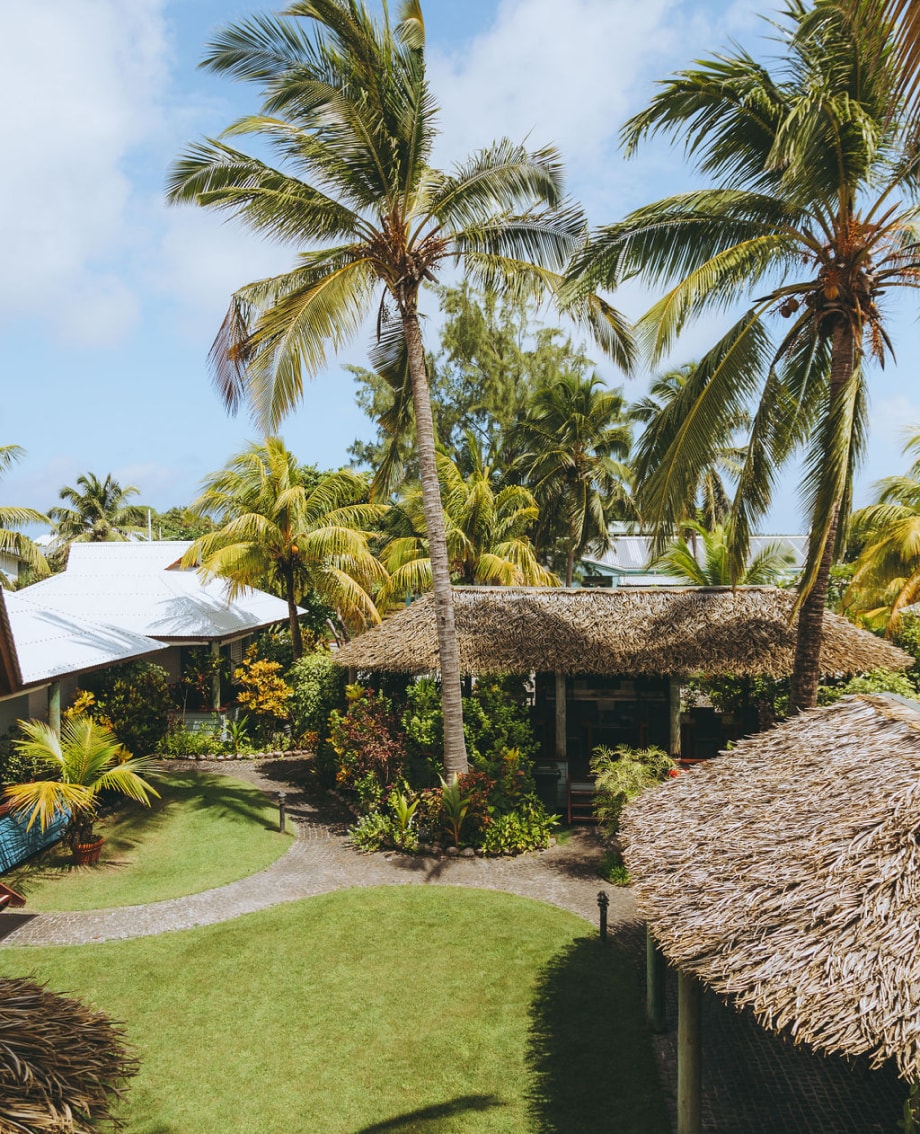
Things to do
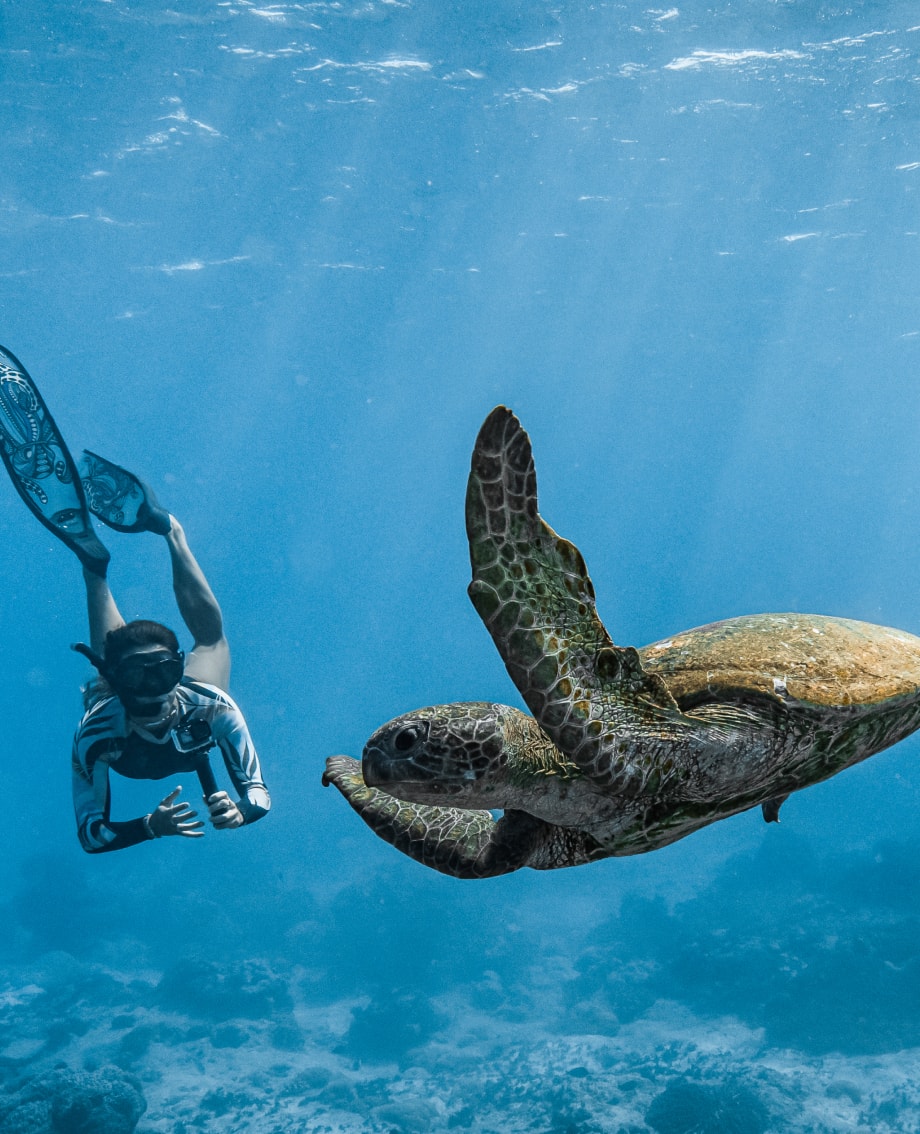
Travel Tips
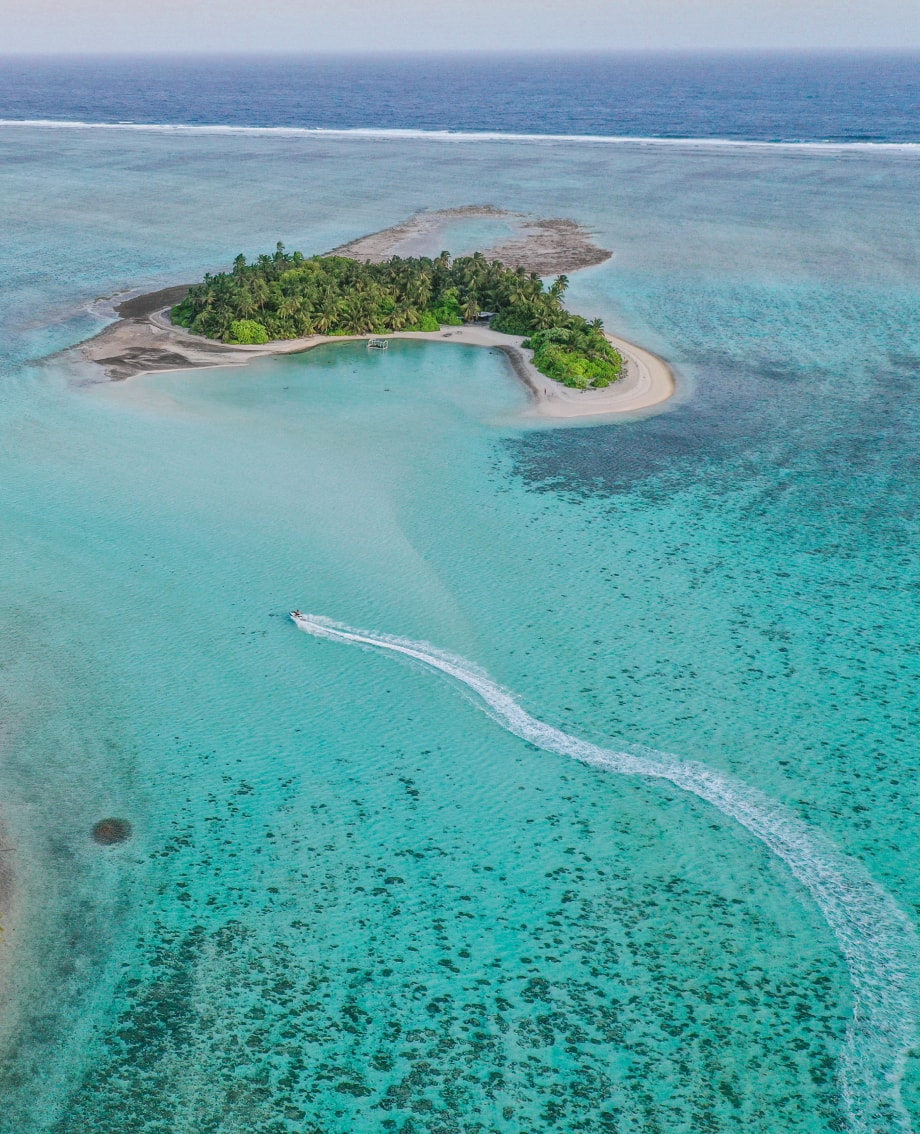

Welcome to the Cocos Keeling Islands
A 14.2 sq km drop in the Indian Ocean.
Immerse in a tropical oasis of coconut palms, endless white-sand beaches and azure waters. Experience one of the world’s largest marine parks teeming with wildlife, discover the unique Cocos Malay culture and historical dramas, and join the friendly locals on island time.
Adventure, or simply take a breath.
Horsburgh Island

Direction Island

Home Island

South Island

West Island

Island Life
A bird watcher’s paradise, known for special sightings of vagrant shoreboards and megabirds, with 39 resident species taking flight across the atoll.
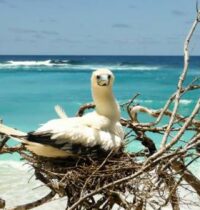
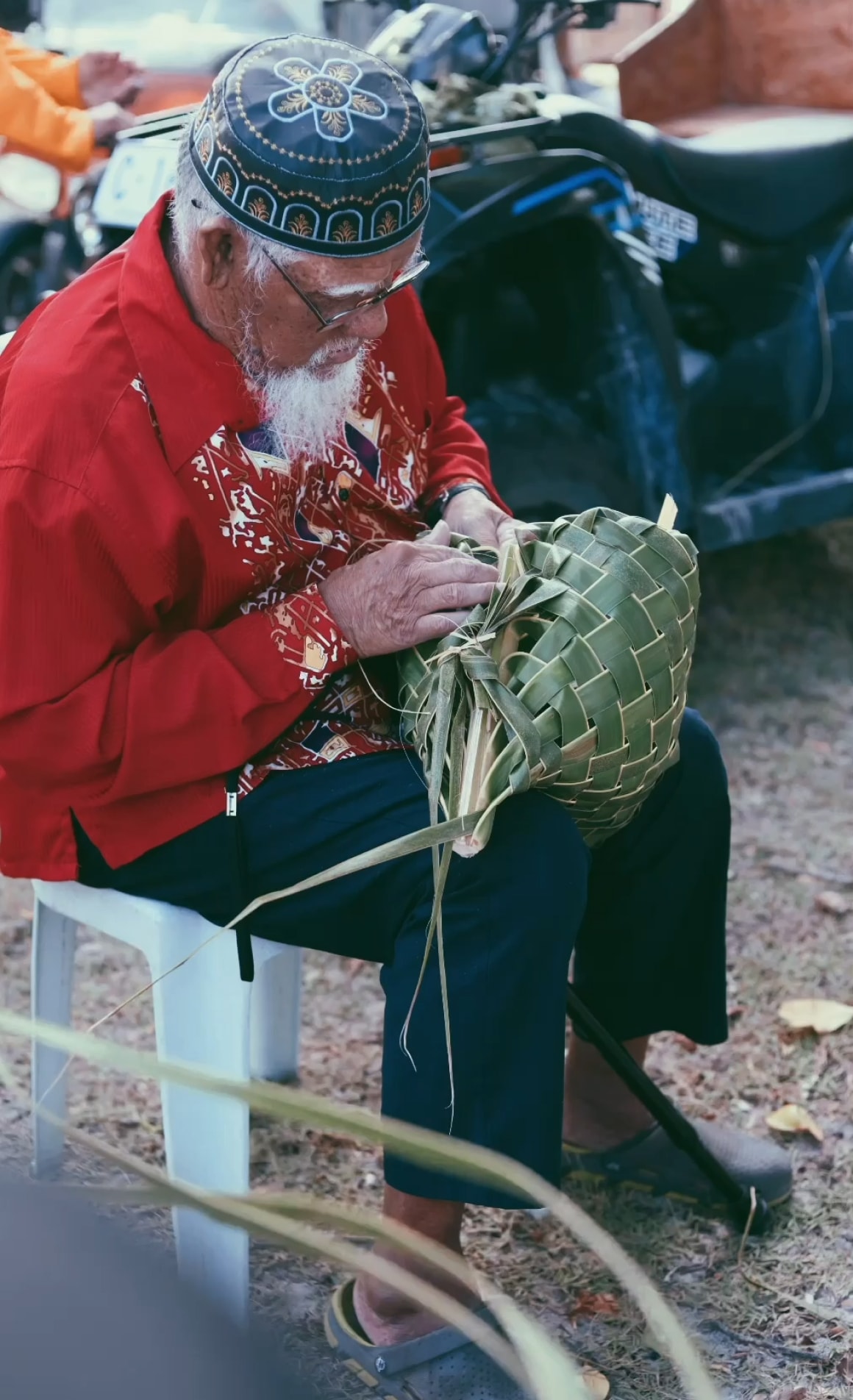
How to get here
Flight information
Eat & Drink
What's on the islands
Transportation
Car Hire & Ferry
Before you get here
Travel tips
Activities The ideal location for kite surfers who are looking for small crowds, lots of space and perfect conditions.
The waist-deep, warm, crystal-clear waters offer the perfect conditions for beginners to learn and for experienced kite surfers to play. Qualified and experienced instructors are available for the entire trade-wind season to practice in a safe and supported environment.
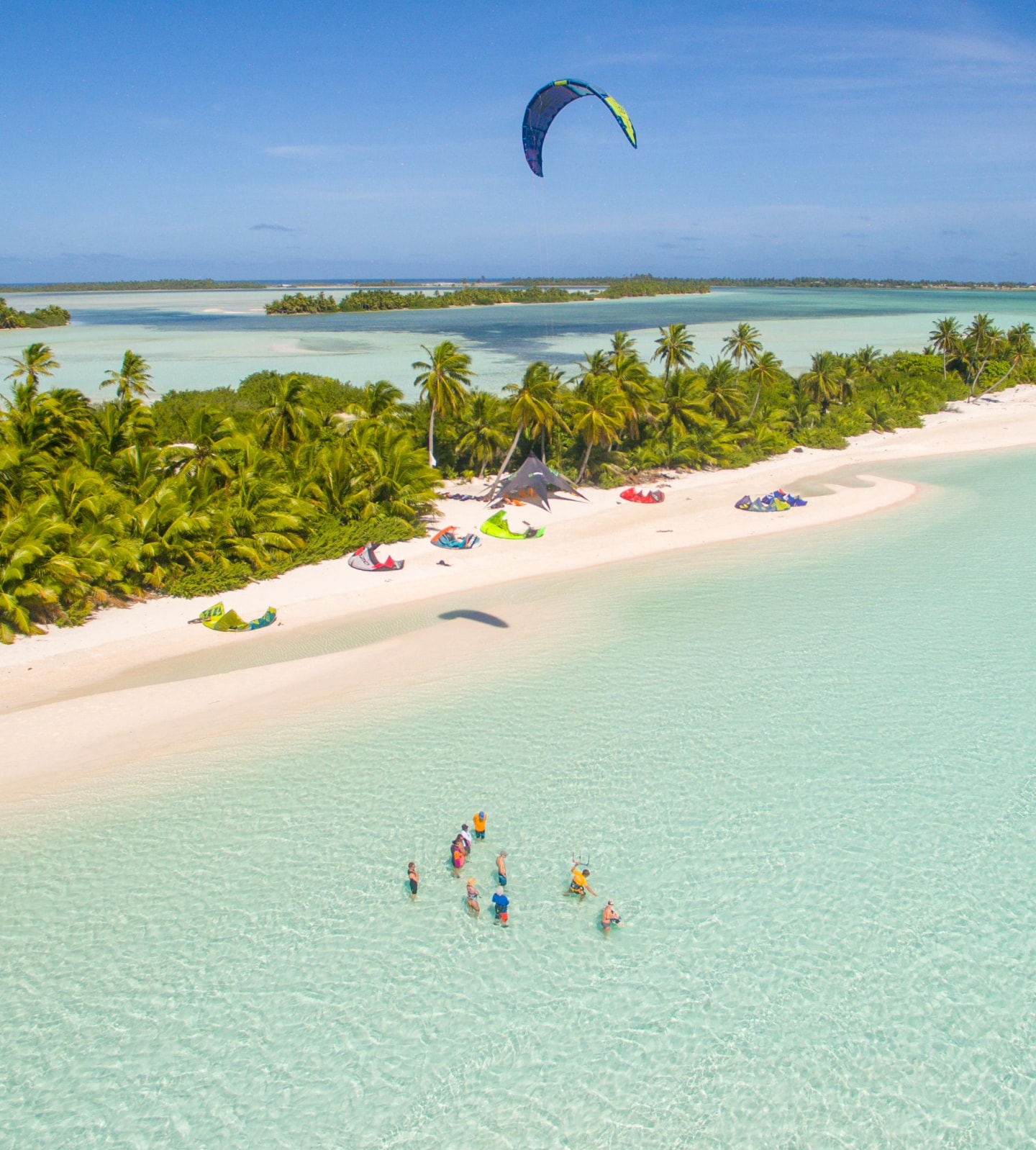
Testimonials
It is rare, in this day and age, to come upon a place so delightful in both looks and temperament that, on the very first sighting, one’s jaw does genuinely drop. Georgia Rickard Australian Traveller
If going with the flow is how you roll, you will love the Cocos Keeling Islands. They have a small – very small – country town vibe. Your activities revolve around the exquisite lagoon whether they be snorkelling, diving, fishing, parasailing, or just relaxing under a coconut palm reading a book while inhaling the frangipani infused air Steve Klein Curious Campers
Scuba diving at Cocos Keeling islands is nothing short of spectacular. Fabulous visibility, pristine coral reefs, abundant marine life and all the trappings of a tropical paradise without the flashy resorts. Yes, it is isolated and it takes some effort to get there, but this is more than offset by the quality of the diving, the friendly locals and the very laid back and relaxing ambience of the entire place. It is quirky, fun and a great place for a holiday. We will return and soon Phillip Tubb Melbourne
Don’t miss this place. My wife and I recently spent a fantastic week on Cocos Keeling Islands. We took the opportunity to take the twice weekly ferry service from West Island to Direction Island... we loved it so much we came back for a second time. Mike G Joondalup
Home Island is definitely quieter than West Island with religion a big part of daily life but the locals were so friendly and welcoming. It was so nice to be able to swim straight off the shore in amazing turquoise water while we cooked BBQs at sunset. Highly recommended! Pete
- Enter Costa Rica
- Attractions
- National Parks and Refuges
- Cocos Island
Cocos Island National Park
Cocos Island National Park: Nestled in the vast expanse of the Pacific Ocean, some 330 miles (523 km) off the coast of Costa Rica, Cocos Island National Park, also known as Isla de Coco, emerges as an unrivaled gem. This pristine sanctuary, just 5 degrees north of the equator, holds a unique status, perched a few hundred miles north of the illustrious Galapagos Islands. Established in 1978, the park is a resolute guardian of unparalleled ecological diversity, safeguarding the habitats vital to marine wildlife, particularly pelagic species, including awe-inspiring sharks. Its exceptional significance led to UNESCO's World Heritage Site designation in 1997. Governed by the Costa Rican government, this natural haven expanded its protective embrace in 2011 with the establishment of the Seamounts Marine Management Area, a sprawling sanctuary five times the size of the existing park. Cocos Island, a beacon for scuba diving enthusiasts , has earned its place among the world's premier dive destinations, boasting over 20 mesmerizing dive sites encircling its shores.
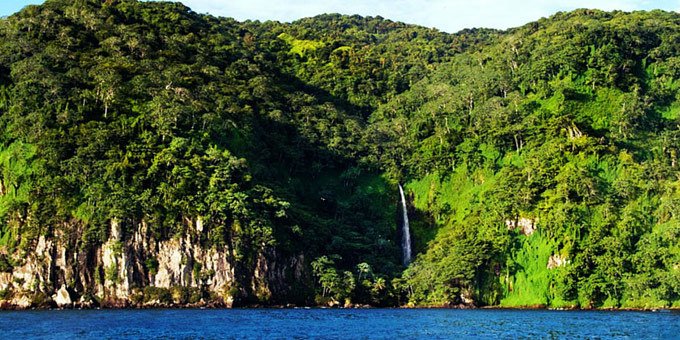
Free Vacation Planning
Cocos island national park: costa rica's subaquatic sanctuary of wonders.
Beneath the Surface: Delve into the depths of the Pacific and uncover the wonders of Cocos Island's underwater realm, a haven where rays, dolphins, and even majestic whales grace your aquatic odyssey. As you explore the warm, azure waters surrounding the island, prepare to be enchanted by a marine ballet of unparalleled splendor. Encompassing Majesty: Cocos Island National Park sprawls across a staggering 199,700 hectares (493,469 acres), a realm that encompasses both the island itself and the protected oceanic expanses that envelop it. This enchanting island spans 2,383 hectares (5,888 acres) and boasts an elevation spectrum ranging from sea level to the majestic summit of Cerro Iglesias, soaring 634 meters above the ocean's surface. The island's interior is a verdant tapestry of mountainous tropical rainforests, adorned with lush ferns, vibrant bromeliads, thriving mosses, and whimsical fungi. Within this landscape, meandering rivers, cascading waterfalls, picturesque valleys, and dramatic cliffs converge in harmonious unity. Marine Marvels: Surrounding this terrestrial Eden lies a marine ecosystem of unparalleled richness, replete with vibrant coral reefs, volcanic tunnels, hidden caves, and the mysteries of the deep. Here, the ocean's symphony is performed by a breathtaking ensemble of diverse species. Yet, with its formidable ocean currents and precipitous drop-offs, Cocos Island's underwater paradise is a realm best explored by experienced divers. Accessible solely via live-aboard boat tours, Cocos Island welcomes those with park ranger permission to explore its captivating shores, though collecting of flora, fauna, or minerals, as well as camping, remains strictly prohibited. Subaqueous Encounters: Underwater enthusiasts will be spellbound by the marine wonders of Cocos Island. Dive into a realm where encounters with white-tip reef sharks and majestic whale sharks are part of the daily spectacle. Over 400 species of coral, an abundance of crustaceans and mollusks, and a mesmerizing array of 300 fish species, including the regal yellowfin tuna and the gentle giant manta ray, coalesce in this mesmerizing aquatic tapestry. Furthermore, the underwater stage sees the grand arrival of humpback whales, pilot whales , playful bottlenose dolphins, and the graceful sea lions. Not to be outdone, hawksbill, green, and olive ridley turtles grace these waters with their presence. Winged Voyagers: Cocos Island's allure extends beyond its aquatic domain, as it beckons avian adventurers with the captivating presence of migratory seabirds. Brown Boobies, Red-footed Boobies, Great Frigatebirds, White Terns, and Brown Noddies elegantly grace the skies. On terra firma, seven species of land birds, including the endemic Cocos Cuckoo, Flycatcher, and Finch—cousins to Darwin's famed finches of the Galapagos—add to the island's ornithological wonder. While two endemic lizard species, an anole and gecko, inhabit the island, amphibians remain elusive. Nonetheless, over 400 species of insects complete this vibrant ecosystem. Cocos Island's wildlife, having evolved in splendid isolation, has given rise to unique endemic species found nowhere else on Earth. A Legacy of Legends: Cocos Island harbors a treasure trove of legends and mysteries, rooted in its captivating history. As the backdrop for documented pirate activity, the island is said to conceal hidden pirate treasure, luring countless adventurers in search of these fabled riches. While small caches have been unearthed, Cocos Island continues to captivate with its enigmatic allure. It is widely believed that Robert Louis Stevenson's "Treasure Island," the desert island in "Robinson Crusoe," and the fictional Isla Nublar in "Jurassic Park" all found inspiration in the mystique of Cocos Island. However, the island faces a pressing challenge in the form of invasive species, such as pigs, goats, and rats, introduced by 18th-century whale hunters. These creatures continue to threaten native species, underscoring the ongoing battle to preserve this ecological jewel.
Cocos Island Facts
Region : Pacific island Closest town : None Size in hectares : 199,700 (493,469 acres) Year established : 1978 Elevation in meters : 0 – 634 (0 – 2,080 feet) Private managed : no Government managed : yes Rangers station : yes Overnight facilities : no Public restrooms : no Entrance fee : $50 Days : daily Hours : 08:00 - 15:30 Hiking trails : no Boat tours : yes Average temperature range in Fahrenheit : 70 - 90 Average yearly precipitation in millimeters : 7,000 Habitat : coral reef, rainforest, beach
From the port of Puntarenas, it is a 32-36 hour boat ride to Cocos Island. Live-aboard boat tours often incude transport to Puntarenas from your hotel in San Jose.
Weather and packing
The climate of Cocos Island is humid and tropical. Temperatures remain the same nearly year round with average day time highs in the upper 80s to low 90s and night time lows in the 70s. Average annual rainfall is 700cm/ 275 inches. Precipitation is high throughout the year, although lower from January through March and slightly lower during late September and October . Depending on your diving preference, calmer seas and better visibility are found between January and May . However the rainier months of June through December are a better time to dive with hammerhead sharks. Annual visitation to Cocos Island is about 1100 people, mainly between March and May.
Visitors should pack a bathing suit, towel, shorts, tee shirts, appropriate shoes, rain gear, sun block, and insect repellent.
Fun Fact: Due to the abundance of documented Pirate activity in the area, Cocos Island is believed by many to be a place to find pirate treasure.
Latitude: N 5° 31' 40.65" Longitude: W 87° 3' 26.71"
Unsure of what to do? Let us make you a free custom trip plan!

Australia Recommends 2024

Come and Say G'day

G'day, the short film

Discover your Australia

Travel videos

Deals and offers

Australian Capital Territory

New South Wales

Northern Territory

South Australia

Western Australia

External Territories

The Whitsundays

Mornington Peninsula

Port Douglas

Ningaloo Reef

Airlie Beach

Kangaroo Island

Rottnest Island

Hamilton Island

Lord Howe Island

Tiwi Islands

Phillip Island

Bruny Island

Margaret River

Barossa Valley

The Grampians

Hunter Valley

McLaren Vale

Glass House Mountains

Alice Springs

Uluru and Kata Tjuta

The Kimberley

Flinders Ranges

Kakadu National Park

Eyre Peninsula

Karijini National Park

Great Barrier Reef

Blue Mountains

Daintree Rainforest

Great Ocean Road

Purnululu National Park

Cradle Mountain-Lake St Clair National Park

Litchfield National Park

Aboriginal experiences

Arts and culture

Festivals and events

Food and drink

Adventure and sports

Walks and hikes

Road trips and drives

Beaches and islands

Nature and national parks

Eco-friendly travel

Health and wellness

Family travel

Family destinations

Family road trips

Backpacking

Work and holiday

Beginner's guide

Accessible travel

Planning tips

Trip planner

Australian budget guide

Itinerary planner

Find a travel agent

Find accommodation

Find transport

Visitor information centres
Deals and travel packages

Visa and entry requirements FAQ

Customs and biosecurity

Working Holiday Maker visas

Facts about Australia

Experiences that will make you feel like an Aussie

People and culture

Health and safety FAQ

Cities, states & territories

Iconic places and attractions

When is the best time to visit Australia?

Seasonal travel

Events and festivals

School holidays

Public holidays
How to get to Australia's most iconic cities

How long do I need for my trip to Australia?

How to travel around Australia

Guide to driving in Australia

How to hire a car or campervan

How to plan a family road trip

How to plan an outback road trip

Cocos (Keeling) Islands © Cocos Keeling Islands Tourism Association
Guide to Cocos (Keeling) Islands
- Share Share on Facebook Share on Messenger Share on Twitter Share on WhatsApp Copy Link
- Getting to Cocos (Keeling) Islands
- When to visit
Discover Australia’s most remote and idyllic outpost, the Cocos (Keeling) Islands.
The Cocos (Keeling) Islands, or simply “Cocos” to locals, are 27 breathtaking islands in an almost perfect circle – only two of which are inhabited. Snorkel, boat, fish, kite surf or dive in the warm, crystal-clear lagoon which forms one of the largest marine sanctuaries in the world. Discover the unique Cocos Malay culture or simply relax on empty white-sand beaches. With just 600 residents and visitors capped at 144 at any time, these tropical islands offer a world away.
Flights operate from Perth to Cocos (Keeling) Islands two times per week (Tuesday and Friday). The flight duration is under five hours and includes a stop at Christmas Island, perfect for extending your trip. Although a domestic route, the flight to Cocos departs from the T1 International Terminal in Perth, and you'll need photo identification to clear customs.
- Cocos (Keeling) Islands Airport (CCK) is located on West Island
- The airport is a short drive from much of the island’s accommodation
Though West Island is small, consider hiring a car or scooter to explore at your leisure. Bicycles are also available for more active visitors.
For more Cocos (Keeling) Islands travel tips, visit the website .
The Cocos (Keeling) Islands experience a consistent tropical climate year-round. Temperatures rarely drop below 24°C (75°F) even at night, so packing lightweight clothing is a good idea. Rainfall is typically higher between March and July, but this season also brings higher winds perfect for kitesurfing.
- High season: April to November
- Low season: February to March
- Don’t miss: The Hari Raya Puasa (end of Ramadan) celebration on Home Island
Top things to do on the Cocos (Keeling) Islands

14 incredible days on Christmas and Cocos (Keeling) Islands
Island hop between these extraordinary locations on an unforgettable 14-day adventure., destinations near the cocos (keeling) islands.

Christmas Island

The Coral Coast

Travellers' stories

Planning your trip to Australia?
Get expert help from an aussie specialist who has the knowledge and experience to help you plan and book every detail of your trip., featured articles.

We use cookies on this site to enhance your user experience. Find out more . By clicking any link on this page you are giving your consent for us to set cookies.
Acknowledgement of Country

We acknowledge the Traditional Aboriginal and Torres Strait Islander Owners of the land, sea and waters of the Australian continent, and recognise their custodianship of culture and Country for over 60,000 years.
- New Zealand (English)
- United States (English)
- Canada (English)
- United Kingdom (English)
- India (English)
- Malaysia (English)
- Singapore (English)
- Indonesia (Bahasa Indonesia)
- Deutschland (Deutsch)
- France (Français)
- Italia (Italiano)
- 中国大陆 (简体中文)
*Product Disclaimer: Tourism Australia is not the owner, operator, advertiser or promoter of the listed products and services. Information on listed products and services, including Covid-safe accreditations, are provided by the third-party operator on their website or as published on Australian Tourism Data Warehouse where applicable. Rates are indicative based on the minimum and maximum available prices of products and services. Please visit the operator’s website for further information. All prices quoted are in Australian dollars (AUD). Tourism Australia makes no representations whatsoever about any other websites which you may access through its websites such as australia.com. Some websites which are linked to the Tourism Australia website are independent from Tourism Australia and are not under the control of Tourism Australia. Tourism Australia does not endorse or accept any responsibility for the use of websites which are owned or operated by third parties and makes no representation or warranty in relation to the standard, class or fitness for purpose of any services, nor does it endorse or in any respect warrant any products or services by virtue of any information, material or content linked from or to this site.

Cocos Island National Park
This national park was declared a World Heritage Site by UNESCO in 1997 for its unmatched natural beauty and rich biodiversity. The island is located between parallels 530' and 534' and meridians 8710' and 876' The blue-turquoise water is extraordinarily clear and makes a great habitat for an abundance of marine life, making this island one of the most extraordinary places in the world for diving. It also has beautiful evergreen forests and numerous impressive waterfalls. For visitors, there is an information center, a park ranger’s station, trails, signage, restroom services, potable water and several lookout points.
Planning your Trip to Costa Rica
Suggested itineraries
Accommodations
Restaurants
Other Activities
Local Travel Agencies
Travel Tips
#EssentialCostaRica
Share your experience, .

Take advantage of the search to browse through the World Heritage Centre information.
Share on social media
Unesco social media, cocos island national park.
- Description
Cocos Island National Park, located 550 km off the Pacific coast of Costa Rica, is the only island in the tropical eastern Pacific with a tropical rainforest. Its position as the first point of contact with the northern equatorial counter-current, and the myriad interactions between the island and the surrounding marine ecosystem, make the area an ideal laboratory for the study of biological processes. The underwater world of the national park has become famous due to the attraction it holds for divers, who rate it as one of the best places in the world to view large pelagic species such as sharks, rays, tuna and dolphins.
Description is available under license CC-BY-SA IGO 3.0
Parc national de l'île Cocos
Le parc national de l'île Cocos, situé à 550 km au large de la côte pacifique du Costa Rica, est la seule île du Pacifique tropical oriental possédant une forêt tropicale humide. Son emplacement – au premier point de contact avec le contre-courant nord-équatorial – et la myriade d'interactions entre l'île et l'écosystème marin environnant font de ce parc un laboratoire idéal pour l'étude des processus biologiques. Le monde sous-marin du parc national est devenu célèbre et de nombreux plongeurs le considèrent comme le meilleur endroit au monde pour observer les grandes espèces pélagiques comme les requins, les raies, les thons et les dauphins.
منتزه جزيرة كوكوس الوطني
يُشكّل منتزه جزيرة كوكوس الوطني، الواقع على مسافة 550 كيلومترا في عرض ساحل كوستاريكا المتوسطي، الجزيرة الوحيدة للمحيط الهادئ الإستوائي الشرقي التي تنعم بغابة إستوائيّة رطبة. وبفضل موقعه عند أوّل نقطة تلاقي مع التيّار البحري الإستوائي الشمالي المضاد وتفاعله بين الجزيرة والنظام البيئي البحري المحيط، أصبح هذا المنتزه مختبراً مثالياً لدراسة العمليّات البيولوجيّة. وقد ذاع صيت عالم ما تحت البحار في هذا المنتزه الوطني الذي يعتبره العديد من الغطّاسين أفضل مكانٍ في العالم من أجل مراقبة الأصناف المحيطيّة الكبيرة مثل سمك القرش والشفنين والتنّ والدلفين.
source: UNESCO/CPE Description is available under license CC-BY-SA IGO 3.0
科科斯岛国家公园距哥斯达黎加太平洋海岸550公里,是热带东太平洋上唯一拥有热带雨林的岛屿,其位置最接近北赤道逆流,又是该岛和周围海洋生态系统全面相互影响的地方,因此这个地区是研究生物进程的理想实验室。公园的海底世界非常著名,吸引了众多的潜水员,因为这里被认为是世界上观看远洋生物的绝佳地点,鲨鱼、鳐鱼、金枪鱼以及海豚等随处可见。
Parque Nacional Isla del Coco
Situada a 550 km del litoral costarricense, la Isla del Coco es la única de la zona tropical del Pacífico Oriental que posee un bosque húmedo tropical. Es un laboratorio ideal para el estudio de los procesos biológicos, debido a su ubicación en el primer punto de contacto con la contracorriente norecuatorial y a sus múltiples interacciones con el ecosistema marino circundante. Los fondos marinos del parque nacional son famosos y muchos submarinistas estiman que son los mejores del mundo para observar especies pelágicas de grandes dimensiones, como tiburones, rayas, atunes y delfines.
source: NFUAJ
Nationaal park Cocos eiland
Het nationaal park Cocos Eiland ligt 550 kilometer van de Pacifische kust van Costa Rica en is het enige eiland in de tropische oostelijke Stille Oceaan met een tropisch regenwoud. Het gebied is een ideaal onderzoeksgebied voor de bestudering van biologische processen. Ten eerste omdat het eiland het eerste contactpunt vormt met de noordelijke equatoriale tegenstroom. Ten tweede vanwege de talloze interacties die plaatsvinden tussen het eiland en het omringende mariene ecosysteem. De onderwaterwereld van het gebied is bekend geworden vanwege de populariteit bij duikers. Zij beschouwen de plek als een van de beste plaatsen ter wereld om haaien, roggen, tonijn en dolfijnen te bekijken.
Source: unesco.nl
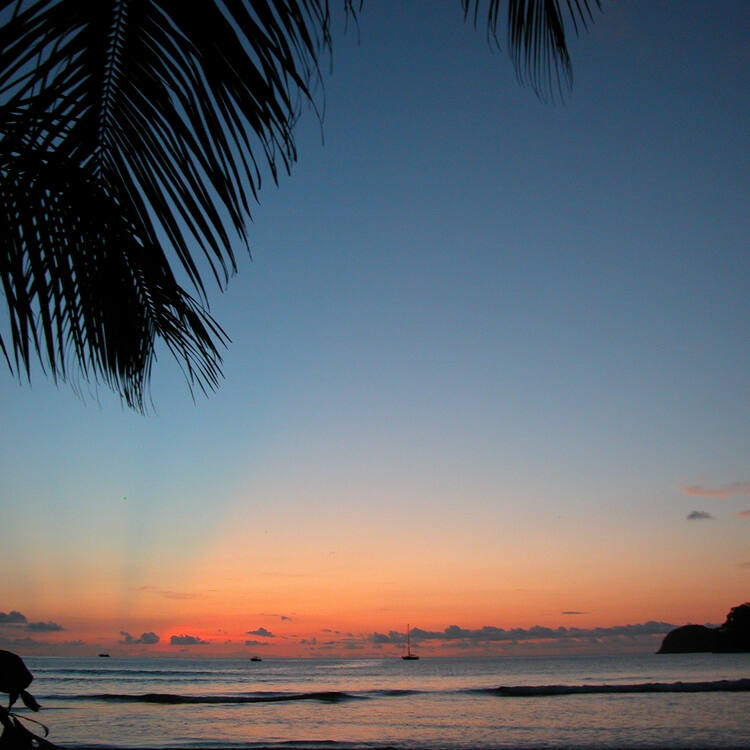
Outstanding Universal Value
Brief synthesis
Cocos Island National Park is located in the Eastern Tropical Pacific, covering an area of 202,100 hectares some 530 kilometers off the Costa Rica mainland. The island itself, “Isla del Coco”, also known as “Treasure Island”, is the only landmark of the vast submarine Cocos Range. With a surface area of 2,400 hectares it supports the only humid tropical forest on an oceanic island in the Eastern Tropical Pacific. The remaining 199,700 hectares protect not only diverse marine ecosystems, mostly pelagic but also, the most diverse coral reefs of the entire Eastern Tropical Pacific. Thanks to its remote location and conservation efforts, the biologically highly diverse property constitutes one of the best conserved marine tropical waters, well-known as a world-class diving destination. The property belongs to the Eastern Tropical Pacific Marine Corridor, a marine conservation network, which also includes World Heritage properties in Colombia, Ecuador and Panama.
Natural population densities of large top predators indicate a near pristine conservation status of a property that is among the most important sites in the Eastern Tropical Pacific for the protection of large pelagic migratory species, such as the endangered Scalloped Hammerhead Shark and the near-threatened Silky Shark and Galapagos Shark. Due to its geographical position, the oceanic island of volcanic origin is the first landmark met by the North Equatorial Countercurrent and a point of confluence of other marine currents. This makes it a dispersing centre of larvae of marine species from various parts of the Pacific Ocean. In its land portion, the property hosts a remarkable degree of endemism across most diverse taxonomic groups. There are, for instance, three endemic bird species, two endemic freshwater fish and two endemic reptile species. Cocos Island National Park is of irreplaceable global conservation value, reminding us what parts of tropical oceans historically looked like.
Criterion (ix): The property harbours a rare and complex mosaic of land and sea environments, including forested mountains, rivers, waterfalls, estuaries, cliffs, sandy and rocky beaches, bays, and extensive and highly diverse coral reefs and pelagic environments. The oceanic island, more than 500 kilometers off the continent, is mostly occupied by tropical rainforest and, from around 500 m.a.s.l. to the highest elevation at 634 m.a.s.l., by cloud forest. The isolation has been allowing ongoing evolutionary processes on land, giving origin to countless endemic species in the most diverse taxonomic groups, including several vertebrate species. The geographic location at the meeting point of the North Equatorial Countercurrent with other major marine currents and the ecological interactions between a remote island and the surrounding marine ecosystems are of major scientific importance. The currents and the island affect the movements and distribution of the many migratory marine species aggregating for feeding and reproduction in the waters around the island. The property serves as a dispersion centre of larvae of numerous marine species coming from the entire Pacific. The islets and rocks around the main island are reported to also serve as important cleaning stations, i.e. pelagic species aggregate to have parasites removed by specialised fish and other species.
Criterion (x): The small island supports the only tropical forest ecosystem located on an oceanic island within the Tropical Eastern Pacific. It is home to some 70 endemic species of vascular plants and several endemic animals, including three birds, two reptiles and even two freshwater fish. Smaller satellite rocks around the island support nesting and resting habitats for numerous migratory and resident bird species. However, the main species conservation value derives from critical marine habitat and the corresponding role of the property in the conservation of large pelagic species, especially several species of sharks. Among the latter are exceptional aggregations of the near-threatened Silky and Lemon Shark, the vulnerable Bigeye Thresher Shark and Galapagos Shark, the emblematic and endangered Hammerhead Shark, as well as White-tip Reef Shark and Black-tip Shark. Among some 300 recorded fish species are important aggregations of large pelagic fish, such as the vulnerable Whale Shark and Blue Marlin, as well as Sailfish Broadbill Swordfish, Shortbill Spearfish, Giant Manta Ray and Pelagic Stingray. Blue Whale and Bottlenose Dolphin are among the visiting marine mammals.
The isolation of Cocos Island National Park contributes to the safeguarding of evolutionary processes, which are the basis of the notable richness and abundance of land and marine life forms. Provided that alien invasive species of both flora and fauna can be controlled, the conservation prospects on land are promising. In the marine areas, the large aggregations of top predators, including but not limited to numerous shark species, demonstrate the integrity within an intensively fished marine region. The entire property is one of the rare marine no-take areas and as such makes an invaluable contribution to conservation as a safe haven for marine life, and as a nursery and dispersal centre – provided illegal fishing can be kept at bay. While many of the aggregations occur in a relatively small area within the property, the marine limits fail to do justice to the life cycles of the many migratory species. Cocos Island National Park cannot achieve the long-term conservation of species indiscriminately exploited in the wider Eastern Tropical Pacific and elsewhere. The critical factor for the long run integrity not only requires adequate management of the property but also sustainable fishing levels outside of it. The Eastern Tropical Pacific Marine Corridor provides a highly needed framework for international cooperation in this regard.
Protection and management requirements
While there is no evidence of pre-Columbian occupation, fishermen, pirates, whalers, commercial sailors and scientific expeditions have long used Cocos Island as shelter and to procure fresh water. Attempts to settle the island include a brief episode of running a prison, but eventually all such attempts have been unsuccessful. Today the human presence is restricted to a rotating group of conservation staff, tourists, and visiting scientists. The entire property is strictly protected by law, state-owned and managed by Costa Rica’s National Park Service under the Ministry of Environment and Energy in cooperation with other governmental and non-governmental institutions, such as the “Friends of Cocos Island Foundation”. Any extraction of marine resources and all commercial, industrial or agricultural activities are banned. Management planning guides interventions with a focus on planning of public use and tourism, protection of sensitive sites, alien invasive species, scientific research, and the review of relevant legislation. Sufficient staff and funding is needed to secure adequate operations, which is costly due to the remote location.
On land, the main threats are invasive alien species of both flora and fauna. While no mammals originally existed on the island, deer, wild boar, cats and rats have been introduced with complex effects on the ecosystems, as well-documented from small island settings around the globe. Temporary settlers brought plants like guinea grass and coffee. The latter has since been invading the understory of the forests. Continuous monitoring and management are needed to eradicate alien invasive species to the degree possible and to prevent new invasions through and strict and enforced protocols for all visitors to the island. In the waters, illegal fishing is common despite efforts by national authorities and non-governmental organizations. Therefore, continuous monitoring and law enforcement is needed, as is awareness-raising with the fishing industry. Tourism activities around the island, mostly recreational diving, likewise require adequate monitoring and control to prevent disturbance in the highly localised areas of major aggregations of fish, as well as littering and other pollution caused by passing vessels and yachts. Following the 1982/1983 El Niño event, about 90 percent of the coral reefs of Cocos National Park died off, a dramatic reminder how protected areas can be affected by events far beyond their boundaries. Eventually, for conservation to be effective in the long term, measures are needed at a much larger geographical scale. These measures could include extensions, buffer zones and, at the international level, coordination and cooperation with other marine protected areas in the Eastern Tropical Pacific, including World Heritage properties in Colombia, Ecuador and Panama.
- Protectedplanet.net
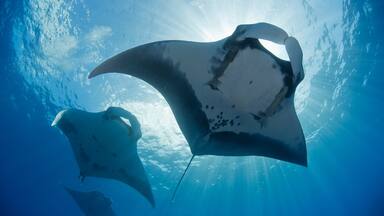
The Nomination files produced by the States Parties are published by the World Heritage Centre at its website and/or in working documents in order to ensure transparency, access to information and to facilitate the preparations of comparative analysis by other nominating States Parties.
The sole responsibility for the content of each Nomination file lies with the State Party concerned. The publication of the Nomination file, including the maps and names, does not imply the expression of any opinion whatsoever of the World Heritage Committee or of the Secretariat of UNESCO concerning the history or legal status of any country, territory, city or area or of its boundaries.
State of Conservation (SOC)
Protections by other conservation instruments.
1 protection / 1 element
- Isla del Coco
Read more about synergies
- All Destinations
- National Parks
- The Pacific
- TRANSPORTATION
- Cost of Living
- Costa Rica Education
- Health Care
- Work in Costa Rica
- Residency Overview
- Restaurants
- 15 Day Weather Forecast
- Weather Regions
- Dry Season vs Wet Season
- Holiday & Festivals
- National Flag
- Customs & Etiquette
Real Estate
- Featured Properties
- Local Real Estate
- Before you buy
- Real Estate FAQs
- Find my Property
- Find my Rental
- Tres Leches
- Rice with Chicken
- Cheese Beans Turnover
- Gallo Pinto
- Costa Rican Food
- Before Doing Business in Costa Rica
- Setting up a Corporation
- Demographics
- Economic Indicators
- Jun. 29-Jun. 29 Saints Peter and Paul Day
- Aug. 2-Aug. 21 Virgin of Los Angeles Day
Travel Blog
- My First Cup of Coffee
- Top Six Extra Things to Pack on Your Next Trip Abroad
- Ten Things to do on the beach in Manuel Antonio
- Eating Alone in Costa Rica
- Nosara Yoga: Switching the Channel
- Riding a bus to Sierpe in Costa Rica
- High speeds, high waves, high in the air over Manuel Antonio
- In-shore fishing off the coast of Manuel Antonio
- Enjoying Puerto Viejo on $28 a day
- How conservation saved Tortuguero
Living in Costa Rica Blog
- Protecting the kinkajous in Manuel Antonio
- Learning Spanish at Rancho Margot
- Backyard Surf Series on Hermosa Beach
- Life in the Monteverde Countryside
- Border Crossing: Nicaragua by Boat
- The Top 5 Reasons I love living in Tamarindo
- A Look Back: Tamarindo, Six Months Later
- Fruit of the Month: Cas
- E-Voting Info for American Expats
- Naturalized Costa Rican Citizenship by Marriage
- Red Eyed Tree Frogs
- White-faced Monkeys
- Scarlet Macaws
- Leatherback Sea Turtles
Itineraries
- 6 Day Best of Activities
- 10 Day Nature Lovers
- 15 Day Best of Destinations
- 12 Day Honeymoon
- 5 Best Waterfalls
- Spectacular Beaches
- Best of Activities
- Best Kept Secrets
- Best of Destinations
- Sky Trek Canopy Tour
- Celeste River Waterfall
- Superman Canopy Tour
- Tortuguero Canal Tour
- Journey to Cocos Island
Medical Tourism
- Dental Care
- Book a Medical Vacation with Us
- Cosmetic Surgery

Cocos Island National Park
Quick facts.
- Location : Pacific Ocean, 340 miles from Puntarenas
- Altitude : 2,080 feet above sea level
- Area : 5,706 acres and 240,171 maritime acres
- Telephone : 2233-4533 or 2283-0022
- Entrance Fee : $25.00
Serpentine coastline, roaring waterfalls, lush rainforest, and sparkling beaches define picturesque Cocos Island, set 340 miles off Costa Rica's southwestern coast. The island's accolades read like a list of superlatives: it is a UNESCO World Heritage Sight, nominated as one of the New Seven Wonders of the World, and designated a Wetland of International Importance under the Ramsar Convention. The beauty of Cocos Island has inspired man for centuries. It has been called "the most beautiful island in the world" by Jacques Cousteau and served as inspiration for Robert Louis Stevenson's Treasure Island and Michael Crichton's Jurassic Park.
Today the island is known as a rich, natural resource, but it was once considered rich for another reason: pirate booty. Cocos Island was an important base for sailors and cartographers since the early 1500’s, and legendary pirate kings like William Davis (1684) and Benito Bonito (1819) are rumored to have buried their treasure here.
Costa Rica acquired Cocos Island in 1869. Between 1872 and 1874, the Costa Rican government ran a prison on the island; it also funded its own treasure-hunting expedition, but no golden doubloons were uncovered. In 1898, naturalists Anastasio Alfaro and Henri Pittier visited the island and suggested it be treated as a protected area.
In 1978, it was designated a Costa Rican national park, part of the nation’s heritage and an important natural resource. Cocos Island is the only point above sea level in Cocos Ridge, a geological line of submerged volcanoes that runs from Costa Rica to just north of the Galapagos Islands. Of volcanic origin, the island’s mineral-rich soil supports tropical lowland ecosystems and a high-montane cloud forest.
Just off the island’s shores, the Pacific Ocean teems with reefs and marine life. It is home to what is probably the largest scalloped hammerhead cleaning station in the world, which attracts these prehistoric creatures by the hundreds. Cocos Island is a crucial habitat for other large pelagic species like dolphins, giant manta rays and at least eight types of sharks.
Cocos Island National Park encompasses the entire island, protecting its lands and waters. It is Costa Rica’s most secluded and least visited national park and can only be reached by a 36-hour boat ride. Home to some of the country’s most stunning scenery and rare wildlife, Cocos Island is well worth the lengthy trek.
Cocos Island is almost entirely covered in rainforest and sees rain most days. There is a short “drier” season from January through March.
Annual Rainfall: 250 inches Temperature: 75º F to 85º F average Ocean Temperature: 84º F to 86º F average
Activities:
Snorkeling and Scuba Diving: Brimming with vast seascapes and copious amounts of wildlife, Cocos Island National Park is considered one of the world's top ten scuba diving destinations. The quality and quantity of marine animal sightings is unprecedented, creating a diver’s paradise – particularly for shark divers. The undisturbed waters and rocky pinnacles surrounding these shores attract scores of hammerheads, white tip reef sharks, jacks, and rays as well as at least 32 types of corals, 57 crustaceans, 118 mollusks and 250 fish species.
Ten-day scuba safaris with private tour companies are available for experienced divers. Divers live on cruise ships that anchor offshore, and the diving takes place off smaller speedboats that hold up to ten divers each. Trips usually include three dives per day, but night dives are available for those who seek extreme underwater adventures. The best time to see large groups of hammerhead sharks is during the rainy season, from May through late November. Visibility is better and currents tamer during the dry season months of January-April.
Volunteer Work: Volunteers are invited to the island to complete tasks from cooking and cleaning to clearing brush and trailblazing. Stays range from one to two months. Meals, lodging and transport from Puntarenas are completely free of charge in exchange for about 40 hours of work per week.
Flora & Fauna:
Cocos Island is the only Pacific Island to receive enough rainfall to support a tropical rainforest. Though the forest is dense, the island is home to relatively few plant and animal species – isolation from other forests creates a closed ecosystem. Plant life includes approximately 235 species of vascular plants, 75 species of fern, 55 species of moss, 85 species of fungi, 106 species of liverwort, and 99 species of lichen. Most species are neotropical and at least 11% are endemic.
The terrestrial fauna of Cocos is also less diverse that that of the Central American mainland. One hundred bird species have been recorded; 13 are resident, seven of which are land birds, and one – the yellow warbler ( Dendroica petechia ) – is endemic to Cocos Island and the Galapagos. The region is also home to five reptile species, including two endemic – no amphibians reportedly inhabit the island. Additionally, 362 insect species have been recorded, with 18% endemic. There are only five terrestrial mammals present on Cocos Island, and all were introduced: pigs, white-tailed deer, goats, cats, and rats.
Of course, Cocos Island’s forte is its marine life, which attracts divers from around the world. Though there are many varieties of coral, there is not a large quantity at Cocos Island, so divers will not see as many colorful reef fish. Other species include: white tip reef shark, black tip shark, silky shark, hammerhead shark, Galapagos shark, bull shark, whale shark, dolphin, bigeye jack, spotted eagle ray, manta ray, marble ray, green sea turtle, giant moray eel, Commerson’s frogfish, rosy-lipped batfish, yellowfin tuna, wahoo, marlin, and sailfish.
There is a $25 fee per person and a $10 diving fee, making it $35 per day for divers and $25 for non-divers. Children under ten are free. Professional filming of the national park carries a $500 fee. Visiting cruise ships are also charged an admission, depending on the size and number of occupants.
Facilities:
Bahia Wafer (Wafer Bay): Located to the north of the island, Wafer Bay has boat anchorage, dining huts, rest areas, showers, and sanitary facilities. An ICE telephone tower is located here, offering wireless Internet and a payphone. Dormitory style cabins as well as double and triple cabins with electricity are offered for volunteers, normally separated by sex but sometimes co-ed. There is also a greenhouse, cafeteria and outdoor gym. There are no overnight facilities for the general public. Contact by satellite phone on the island: 0087-468712-0010
Bahia Chatham (Chatham Bay): Located to the northeast, it offers boat anchorage, dining huts, rest areas, showers, and sanitary facilities.
The island is home to virgin rainforest, spectacular views, and more than 200 waterfalls that beckon adventurous hikers. There is one public trail that connects Chatham Bay to Wafer Bay, and the national park provides guides free of charge. It takes an hour roundtrip, and leads to a gorgeous waterfall. A WWII B24 airplane wreck was discovered north of Cerro Iglesias, but hiking there is prohibited without special permission. Always check with park rangers before setting out on any Cocos Island hike.
Getting There:
Fly into the San Jose International Airport (SJO) or Liberia International Airport (LIR). You may either arrange transportation to Puntarenas, where most dive expeditions to Cocos Island begin, or request that the dive company do so for you. The boat trip from Puntarenas to Cocos Island takes approximately 32-36 hours each way. Some small cruise ships also pass by the island, offering day trips out to its shores.
Cocos Island National Park in Pictures
Diving catalina islands - costa rica.
Cocos Diver Marcosok - Costa Rica
Cocos Bigscalesoldierfish - Costa Rica
Cocos Frogfish - Costa Rica
Colorful Fish Near Cano Island - Costa Rica
Sea Turtle Swimming - Costa Rica
Pacific Green Sea Turtle - Costa Rica
Cocos Rainbowoflife - Costa Rica
Hawksbill Turtle Swimming Cano Island - Costa Rica
Cocos Whitetipblueandgoldsnapper - Costa Rica
Moray Eel South Pacific - Costa Rica
Hammerhead Sharks - Costa Rica
Night Diving Sharks Cocos - Costa Rica
Fish Underwater Cave - Costa Rica
Cocos Whitetipreefshark - Costa Rica
white tip reef shark up close - Costa Rica
spotted eel - Costa Rica
lobster underwater - Costa Rica
Octupus Underwater - Costa Rica
diving coco beach - Costa Rica
coral cano island - Costa Rica
school of manta rays - Costa Rica
striped eel - Costa Rica
coral underwater - Costa Rica
fish underwater - Costa Rica
sea turtle underwater - Costa Rica
moral eel - Costa Rica
starfish underwater - Costa Rica
eel underwater - Costa Rica
ray underwater - Costa Rica
sea anemone - Costa Rica
vibrant seascapes - Costa Rica
purple yellow fish - Costa Rica
Best Hotel Deals in Costa Rica!
- Contact Info
- Testimonials & Reviews
- Advertise with Us!
Signup for our newsletter
Stay in touch and get the inside scoop.
- Privacy Policy
- Terms & Conditions
© 1996-2024 costarica.com, Inc. All rights reserved.
Cocos Island National Park

- 1.1 History
- 1.2 Landscape
- 1.3 Flora and fauna
- 1.4 Climate
- 3 Fees and permits
- 4 Get around
- 11 Stay safe

Cocos Island is a nationally protected jungle-covered island and national park off the coast of Costa Rica . It's also a UNESCO World Heritage site .
Cocos Island is in the Eastern Tropical Pacific approximately 300 mi (480 km) southwest of Cabo Blanco, Costa Rica. A rugged and incredibly beautiful island, today Cocos Island is the most sacred National park in Costa Rica's extensive park system.
Among Cocos Island's many attributes is a startling degree of biodiversity. This island's world-renowned waters explode with life, including innumerable white tip reef sharks, schooling hammerhead sharks, dolphins, mantas and marbled rays, giant moray eels, sailfish, and of course the occasional whale shark. Other common encounters are large schools of jacks and tuna, silky sharks, silver tip sharks, marlin, Creole fish, green turtles and octopus. On the Island you will encounter a lot of pigs and not much else besides the usual vegetation.
The island is supposed to hold three of the largest treasure troves of all time. From pirates to the entire horde of Lima which was hidden there from Simon Bolivar and his troops in 1821.

Cocos Island is a very hilly, dense tropical jungle with over 200 waterfalls and averages over 400 in (10,000 mm) of rain a year. It has three bays and is 24 km² of land.
Flora and fauna
Is hot and very humid. Expect showers lasting a few hours most days between March and December.
As tourists are allowed ashore only with permission of island rangers, there are very limited ways to be able to step foot on the island but one of the best ways to experience this natural beauty is through a dive trip. There are two fully equipped dive boats that do week-and-a-half trips out to the island and back, they are the Okeanos Aggressor [formerly dead link] and Undersea Hunter [dead link] .
Fees and permits
In order to set foot on the island with the intent of treasure hunting requires a permit from the Costa Rican Government. This is because of the large numbers of treasure expeditions that have been seen come through the island over the last 50 years. Over 400 large scale expeditions have been assembled along with tens of thousands of smaller and independent searches.

Getting around the island is a little tricky. The main types of transportation are by foot or bike usually used for hikes and sight-seeing tours. The few locals who live here mainly use foot, or bike, or small motor bikes and dirt bikes.
Since this is an island you will see a lot of ocean, but if you ever get the chance to step foot on the island and are somewhat physically fit, hike to the top of the island with a guide. It is a magnificent view.
The main attraction for Coco island is its unbelievable scuba-diving with its schooling hammerhead sharks. On the island hiking and biking to the top of the island for the spectacular view is an almost must. Other main activities include snorkeling, island hopping, and fishing the waters surrounding the island. Many people go to Cocos just to relax on the beach and enjoy the scenery.
Tourists and are not permitted to stay on the island.
The only possible dangers in Cocos Island are the sharks, eels, and other creatures that might be seen while diving, snorkeling, boating, or fishing.
- UNESCO World Heritage Sites
- UNESCO tag to be fixed
- Articles without Wikipedia links (via Wikidata)
- Has custom banner
- Articles with formerly dead external links
- Articles with dead external links
- Has Geo parameter
- All destination articles
- Outline parks
- Outline articles
- Park articles

Navigation menu
Global National Parks
National Parks of the World: Tourism, Accommodation, Routes, and Guides
Home » North America » National Parks in Costa Rica
Cocos Island National Park
- 1.1 Geographic Location and How to Get There
- 1.2 Recognitions and Designations
- 2.1 Pre-Colombian Times and Discovery
- 2.2 Designation as a National Park and its Evolution
- 3.1 Endemic Species
- 3.2 Characteristics of Flora
- 3.3 Animal Life: Terrestrial and Marine Fauna
- 4.1 Hiking: Trails and Recommendations
- 4.2 Scuba Diving: Popular Sites and Marine Life to Observe
- 4.3 Birdwatching and Other Wildlife Activities
- 5.1 Threats to Biodiversity and Conservation Efforts
- 5.2 Scientific Research on the Island
- 6.1 Best Time to Visit and Climate
- 6.2 Visitor Regulations and Necessary Permits
- 6.3 Health and Safety
- 6.4 Accommodation and Food
- 7 Cocos Island and Treasure Island
- 8 Photo Gallery
Embark on a journey to one of the most intriguing and biodiverse places on Earth, Cocos Island National Park (in Spanish: Parque Nacional Isla del Coco ) in Costa Rica . A pristine paradise with a land area of 23.85 km², known as the "Treasure Island," it is a remote Eden where nature and legend merge. Here’s a detailed guide to explore this natural gem, brimming with unique wildlife, towering landscapes, and thrilling adventures.
Introduction to Cocos Island National Park
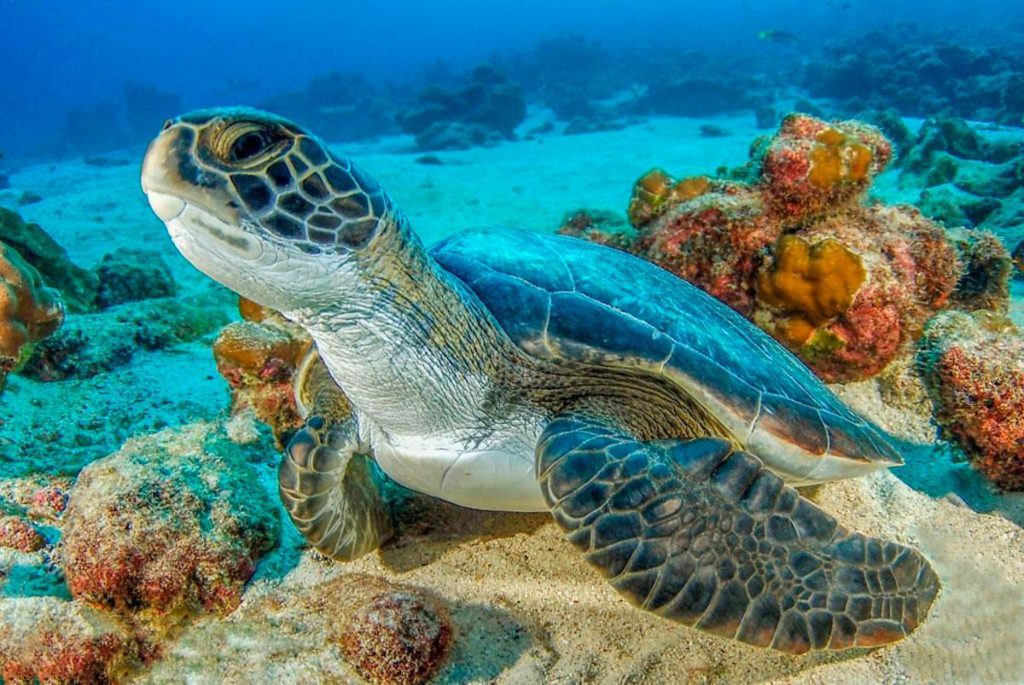
Geographic Location and How to Get There
Located 550 kilometers off the Pacific coast of Costa Rica, reaching Cocos Island National Park is an adventure in itself. Visitors often embark on a several-day boat journey , preparing for the unique experience offered by this remote paradise.
Recognitions and Designations
Recognized as a UNESCO World Heritage site since 1997, the park is famous for its rich biodiversity and stunning natural beauty.
History of Cocos Island National Park
Pre-colombian times and discovery.
The island has a rich and fascinating history , from its volcanic origins to legends of hidden pirate treasures. Although uninhabited, the island was an important stopping point for sailors and pirates during the 17th and 18th centuries.
Designation as a National Park and its Evolution
In 1978, Costa Rica designated Isla del Coco as a national park. Since then, significant efforts have been made to preserve and protect its unique biodiversity .
Flora and Fauna of Cocos Island
Endemic species.
The park is home to an astonishing number of endemic species, including various birds, plants, and invertebrates. Among the most notable is the Hammerhead Shark , one of the main attractions for divers.
Characteristics of Flora
The island is largely covered in tropical rainforest, with an exceptionally rich and diverse ecosystem.
Animal Life: Terrestrial and Marine Fauna
From colorful tropical fish to spectacular seabirds, the park is a sanctuary for a variety of wildlife . Green turtles ( Chelonia mydas ), hammerhead sharks, whale sharks, white-tip sharks, and tiger sharks can be found in its waters. Manta rays ( Manta birostris ), coral formations, gorgonians, and various varieties of sea sponges also inhabit its waters.
Activities and Attractions
Hiking: trails and recommendations.
The island offers a variety of hiking trails that pass through dense forests and lead to impressive waterfalls. The trail to the Genio Waterfall is a popular choice, with its spectacular 90-meter drop.
Scuba Diving: Popular Sites and Marine Life to Observe
The park is famous for its diving sites, with Bajo del Diablo and Roca Sucia being some of the most prominent. Visitors can expect to see manta rays, hammerhead sharks, and an impressive diversity of marine species .
Birdwatching and Other Wildlife Activities
The island is a paradise for birdwatchers, with endemic species like the Cocos Island Finch. Additionally, dolphins, whales, and sea turtles can be observed.
Conservation and Research
Threats to biodiversity and conservation efforts.
Despite its isolation, the island faces threats from poaching and illegal fishing. Conservation efforts are crucial to preserve its pristine ecosystem.
Scientific Research on the Island
The island serves as a significant center for scientific research, particularly in areas such as marine biology and ecology.
Practical Information for Visitors
Best time to visit and climate.
Cocos Island National Park has a year-round humid tropical climate. The best time to visit is during the dry season, from December to April .
Visitor Regulations and Necessary Permits
To visit the island, a permit from the Costa Rican Ministry of Environment and Energy is required. Visitors must adhere to strict rules to ensure the protection of the island’s ecosystem.
Health and Safety
Visitors should be prepared for remote and wild conditions. It is recommended to bring necessary medications, sunscreen, and insect repellent.
Accommodation and Food
Due to its national park status, there are no accommodations or food services on the island. Visitors must plan for their stay and meals on expedition boats.
Cocos Island and Treasure Island
The book "The Desert Island" proposes the theory that Daniel Defoe used Cocos Island as a model to describe the island inhabited by Robinson Crusoe in his famous novel. Although Defoe placed the island off the coast of Venezuela in the Caribbean, instead of the Pacific Ocean, it is argued that Cocos Island could have been a source of inspiration. In Michael Crichton’s fiction novel, "Jurassic Park," the action takes place on the fictional Isla Nublar, which belongs to Costa Rica. Although they do not share an exact location, it is speculated that Cocos Island might have been a source of inspiration for the creation of this fictional island. One evidence supporting this theory is the video game "Jurassic Park: Trespasser" (1998) by DreamWorks Interactive, which uses the topography of Cocos Island.
The novel "La caída del Águila" by Costa Rican writer Carlos Gagini also develops much of its plot on Cocos Island, giving it an important role in the story.
The movie "Island of the Sharks," directed by Howard Hall and one of the first IMAX films, was filmed and inspired by Cocos Island, capturing its natural beauty and the surrounding marine life.
Photo Gallery

Best Tour to Coco’s Island National Park in Costa Rica
Coco’s Island National Park is one of Costa Rica’s amazingly beautiful eco-tourism island. Its remoteness tickles your mind and imagination of what marine life, tropical animals, or activities to enjoy in this kind of getaway.
One of Costa Rica’s mission is to protect the exotic flora and fauna of every national park in the country, and that includes Coco’s Island National Park. Hence, a trip to the national park with your friends and family will be a once in a lifetime opportunity to witness actual exotic marine life, various plant species, and indigenous wildlife before they become extinct.
Coco’s Island National Park is one of the top bucket lists for most professional photographers. From steps to cliffs to any angle, the park is a sure hit not only to photographers but also to every traveler who wants to escape the hustling bustling city life.
Plus, if you are a seasoned diver, a nature lover, or an adventurer, it is no doubt that you will love a few days of your stay in this charming and dazzling island.
Where is Coco’s Island National Park Located?
Cocos Island National Park is 550 kilometers away from Puntarenas , off Costa Rica’s Pacific Coast and southwest of Cabo Blanco. Additionally, it is a hundred miles away from the famous Galapagos Island.
When is the Best Time to Go to Coco’s Island National Park?
Organize your itinerary well, as we recommend you to explore the island for ten days. The trip from the mainland, Puntarenas , already takes up 30-36 hours of your time.
Since Coco’s Island National Park’s live-aboard operators are few, we recommend that you book your trip 10-12 months in advance to ensure the slot availability of the boats.
Since Coco’s Island is known for scuba diving and if it is the main reason for your visit, we recommend you to plan your trip from January to March. These months have calmer seas and distinctive water visibility in which you can expect to have a show of sharks and big fishes.
The waves get tougher from July through November. It is during these months that you can encounter a considerable number of hammerhead sharks and manta rays.
The wave conditions get better during the dry season from December to May.
How is the Weather in Cocos Island National Park?
Costa Rica is a tropical country; hence, expect the weather to be humid and wet all year round.
The dry season starts from late December to early April. The rest of the months are abundant in rainfalls. Even during the dry season, expect a few downpours, especially in the afternoon. The most decreased downpour often occurs in February.
On the other hand, the intensity of rain pours almost every day from May to October.
How Do You Get to Coco’s Island National Park?
Coco’s Island National Park is a remote area; however, it is accessible only by a liveaboard dive boat tour.
You don’t need to have the headaches of arranging your tour to Coco’s Island National Park since the liveaboard company will take care of everything from San Jose hotels.
Or you can also arrange your trip from San Jose to the city of Puntarenas following the Caldera route. From Puntarenas, you can now organize your trip to Coco’s Island National Park.
Get yourself ready for a 30-36 hour dive boat tour from the mainland, Puntarenas . You can either drop at the offshores of Bahia Wafer on the northwest or Bahia Chatham on the northeast, both bays having sandy beaches.
Though the national park is accessible through liveaboard dive boats, there are only three boats to accommodate every traveler. The Okeanos Aggressor, MV Argo, and Undersea Hunter travel a week and a half to the island; hence, it is advisable to plan and book your seats in advance.
About Coco’s Island National Park
Coco’s Island National Park was established in 1978 to home 270 types of fish, around 235 varieties of plants, over 400 types of insects, and 30 kinds of corals. If you want an undistracted panoramic view of nature, this is the perfect place for you.
Isla del Coco as it is known to Costa Ricans was once a UNESCO World Heritage Site in 1997. It covers more than 493 thousand acres, including the surrounding water areas.
The Costa Rican government ensures that no high-rise buildings or establishments should be built around or nearby the park to preserve the island’s excellent structure and formation, along with the protection of the diverse wildlife and marine life.
Coco’s Island National Park is also known to be a Treasure Island. Stories have been circulating that during the early 1800s, explorers and pirates buried treasures on the island. However, up to this writing, no one has found a treasure map yet to those claimed treasures.
Along with the burying of treasures, seafarers also left pigs, goats, and rats to breed, expecting something to hunt on their next trips. As of today, the effect of these mammals is damaging the extinct species of the island and the park. To that effect, the government is keeping it in control to avoid any harm in the ecosystem.
What to Bring / Wear in Cocos Island National Park?
Visiting Coco’s Island National Park will take you hours and days to reach from San Jose Port. During transportation, travelers are allowed to go diving while you are on your way to the island.
And since Costa Rica is a tropical country, get ready to pack your top choices of bathing suit or trunks, bath towels, shirts, and shorts.
Don’t forget your shoes and slippers along with rain gears, those which are appropriate for the lush green forest of the national park.
Of course, who would forget sunblocks and insect repellents?
Operating Hours and Fees
Enjoy an undisturbed panoramic view along with diverse flora and fauna before it comes to extinction for only $50/head from 8:00 AM to 3:30 PM.
Activities at Cocos Island National Park
Scuba Diving is the main reason why travelers set their foot in Coco’s Island National Park. But if you are not into diving, don’t get disappointed because you can still enjoy the sceneries while aboard the boat on your way to the island. Once you land to the island, take your cameras and video cameras ready and start to amaze yourself doing the following.
1. Trekking
Expose your eyes to the various flora and fauna Coco’s Island National Park has to offer, which you wouldn’t see in the cities or zoos. The floras include mosses, ferns, and bromeliads. You can also witness varieties of migratory birds such as red-footed booby, brown noddy, great frigatebird, flycatchers, finch, cuckoo, and so much more.
2. Scuba Diving and Snorkeling
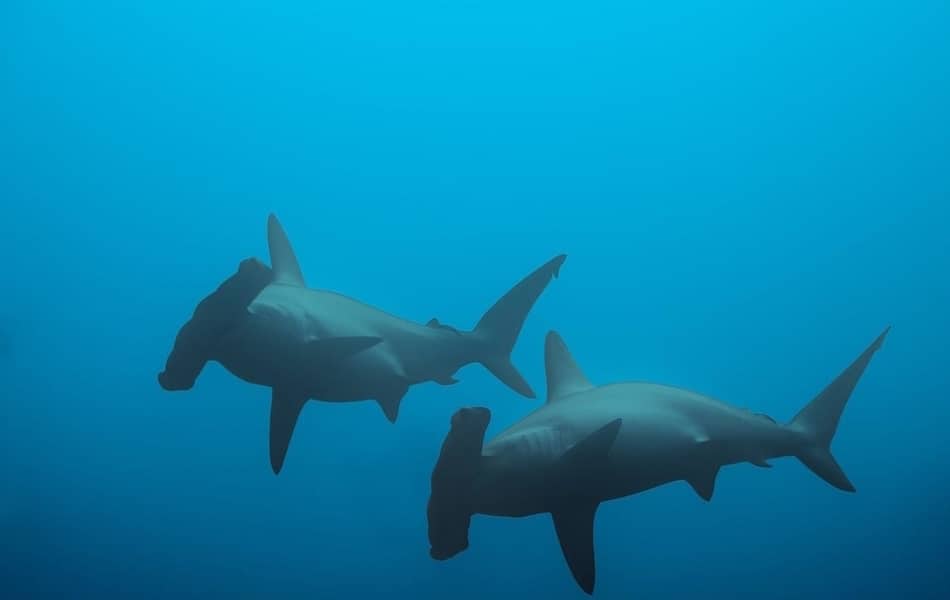
Explore the mysteries and wonders of the sea through scuba diving and snorkeling in one of the world’s top dive spots. Amaze yourself with several volcanic tunnels, various coral reefs, and sea caves.
If the natural habitat is not enough to surprise you, let yourself excite with the views of whale sharks, hammerhead sharks, white tip reef sharks, tiger sharks, silvertip sharks, silky sharks, marbled rays, mantas, dolphins, blue marlin, varieties of fish and snails such as mollusks, crustaceans, yellowfin tuna, sailfish, giant moray eels, octopus, turtles, and more.
Surely, you will exhaust yourself scuba diving with the island’s 20 dive sites to wander and discover its treasures.
The best time to dive here is between June and December . These are some Liveaboards to Cocos Island: Okeanos Aggressor II and Argo .

3. Hike and Swim
Coco’s Island National Park boasts one of the impressive waterfalls in Costa Rica with a swimming pool at the bottom. Don’t worry about getting there because the park rangers will guide you while giving a story about the park’s extraordinary wildlife.
4. Boating and Fishing
If you are not a fan of diving or snorkeling, that’s okay. You can still enjoy the beauty and wonders of the island by boating, fishing, or island hopping. Or you can even just lay on the beach, people watch, wildlife watching, and enjoy the sceneries.
Where to Eat
There are no restaurants in Coco’s Island National Park as it is an isolated island. Therefore, pack something that would last you for days on the island.
Where to Sleep
There are no overnight facilities in Coco’s Island National Park. The only accommodations on the island are the chambers for park rangers. So we recommend you to book your lodging on the nearby areas or from San Jose itself. You may want to try Jaco Royale Hotel, Hotel Punta Leona, Hotel San Bada, Makanda By The Sea, and Terraza Del Pacific Hotel to name a few of the nearby hotels.
Whether you plan for a diving excursion or a nature trekking vacation, Costa Rica’s own Galapagos Island in the name of Coco’s Island National park is the best place to wonder and wander with nature.
The numerous wildlife, marine life, and fauna will bring you to an unimaginative world that some of us didn’t know exists.
As early as now, plan and book your fun adventures to Coco’s Island National Park while the conservation of its remoteness and wildness still hold its value.
The Costa Rica Best Ride Team
Recent Posts
Why is Costa Rica so Expensive? 6 Things that Make it More Expensive Than Other Countries
Costa Rica is a beautiful country with its own unique features. From the capital city, San Jose, to beaches in the Caribbean. It’s a beautiful little country in Central America that is famous for...
Discover 9 best treks in Costa Rica
Known for its amazing natural beauty and bio-diversity, Costa Rica is quickly becoming one of the most popular countries to visit worldwide. Here are the 9 best treks in Costa Rica to have on your...
The best things to do on the Cocos (Keeling) Islands
Journalist + Photographer
08 February 2024
The ‘welcome to Paradise’ brochures handed out at Cocos (Keeling) Islands’ airport after half a day’s travel from Perth perfectly encapsulate Australia’s most remote group of 27 islands that hang in the Indian Ocean like a sparkling tiara.
One of three Australian external territories, those lucky enough to experience its unhurried landscape either stay or lose no time hurrying back; one escape to the deserted sand-draped isles isn’t nearly enough.
Be warned though, Cocos (Keeling) is a hard addiction to break. Picture snorkelling in aquarium-clear waters, swishing in hammocks hooked to palm trees, or simply strolling along the water’s edge, splashing up surf. Whether you crave well-earned R&R, a dab of adventure, or losing yourself in the islands’ rich natural environment, we’ve checked out the following what-to-do and where-to-eat options.
Getting wet on Cocos
Underwater adventures.
Cocos’ horseshoe shape of islands sits in one of the world’s most azure archipelagos, giving the illusion a higher power perhaps created them for ocean lovers.
Join Cocos Dive and book an underwater sea-scooter tour or venture deeper with a dive. Either way, you can explore the islands’ wrecks where teems of tropical fish flit and dart through coral-encrusted hulls.
Since Parks Australia declared the marine park a sanctuary in March 2022, you’ll be snorkelling in waters set to remain pristine and protected.
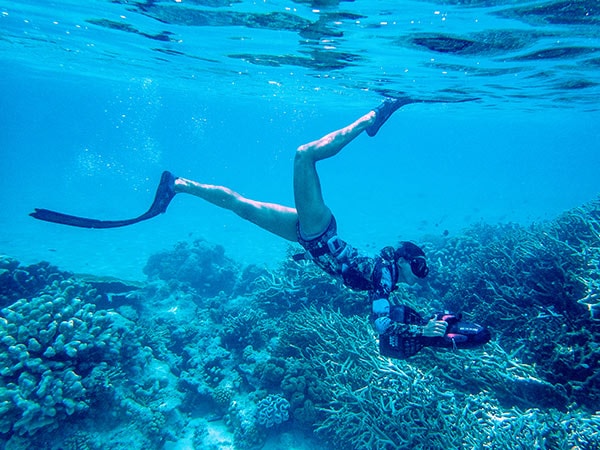
Swim with the protected underwater creatures. (Image: Lynn Gail)
For an experience with a difference, join a Canoe Safari Tour and discover the untouched Southern Islands with Cocos Islands Adventure Tours .
You’ll skim across the lagoon in a motorised canoe, moor at an idyllic isle and indulge in a gourmet champagne picnic. Have your video ready to record the famous Cocos hermit crab race – the commentary alone is a hoot.
Bring your snorkel and sense of adventure – the current will carry you around the tip of Pulu Maria, a tranquil tidbit of an island where coral overflows with magical marine life.
Obsessed with hawksbill and green turtles? Cocos Island Adventure Tours have a tour dedicated to seeing these gentle giants glide as light as ballet dancers through the lagoon.
For a memorable experience, jump in and swim alongside their incredibly handsome shells.
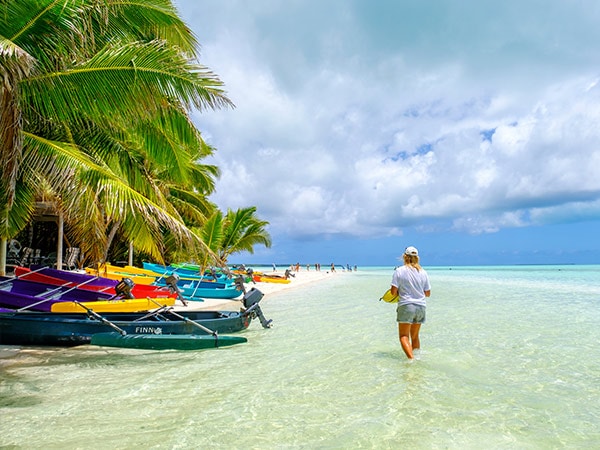
Join in one of many water sports on the island. (Image: Lynn Gail)
Catch-of the-day
If fishing pumps through your gills, jump on half a day’s trip with Glass Bottom Boat Tours and snag a catch for dinner.
Not into game fishing? Admire the star-studded sea life through the boat’s glass panel instead. Bring your snorkelling gear if you want to come eye to-fish-eye with Cocos’ vibrant sea life.
The owners will also moor at surrounding islands for any history buffs on board. Both Prison Island – once home to a harem – and Horsburgh Islands – where the Australian Army established a base during WWII – have intriguing pasts.
Dress to get wet and explore the islands’ Eastern Atolls with Cocosday Tours . Snorkel around coral reefs brimming with exotic fish or choose an outlying island to bask and beachcomb to your heart’s content.
A couple of onboard stand-up paddle boards will help you work up an appetite for the included champers and nibbles.
Cocosday Tours also offers fishing tours around the reef flats. Catch Coral Trout, Bluefin Trevally, Red Bass or Yellow lip Emperor using their high-quality fishing gear.
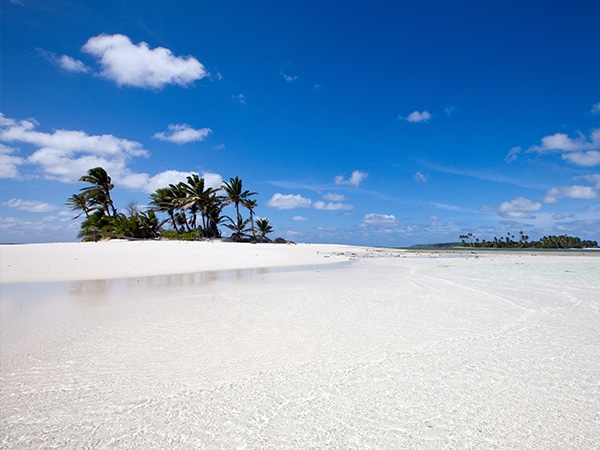
Take in the sparkling waters and black-tipped sharks surrounding Prison Island. (Image: Lynn Gail)
Take to the air
During July to September, trade winds bring perfect conditions for kite surfing. Fly like a bird over West Island’s curvaceous shoreline with Zephyr Tours or Ape X Kiteboarding – it’ll be an adventure like no other with these experienced kite school tour operators.
The instructors will show you the ropes and have you soaring over a translucent lagoon spotting turtle, black-tip reef sharks and shoals of fish.
Both Zephyr and Ape X Kiteboarding are one-stop shops offering packages including accommodation, transport, and island adventures along with unlimited kite lessons.
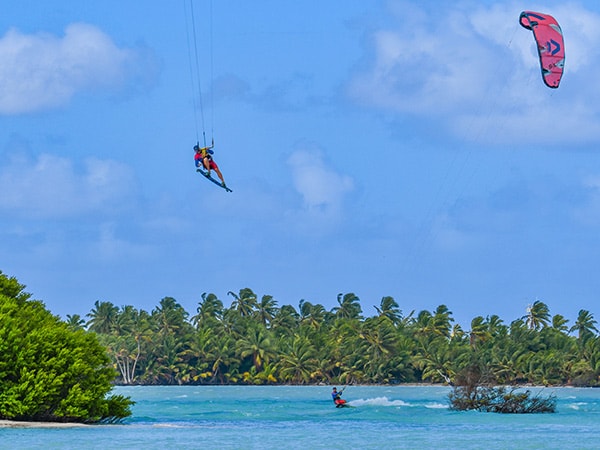
Take to the skies on a Zephyr Tour.
Staying dry on Cocos
Artistic endeavours.
Step down into the hull of a restored barge of Big Barge Art Centre , lined with one-off art pieces made from washed-up flotsam and jetsam.
Local artist, Emma Washer pulled the colossal broken-down ship, the Biar Selamat (meaning ‘let’s be safe’) from the overgrown jungle back in 2001.
Emma devoted over 10 years to turn her vision of creating an art gallery into a reality. The 19-metre-long art centre now sits in a prime beachfront location and offers various workshops on recycling washed-up waste.
A recently added boho-styled café, built from recycled boat timbers, serves a range of hot drinks and tasty treats to enjoy as the waves roll in. Check opening hours with the Visitor Centre on West Island.
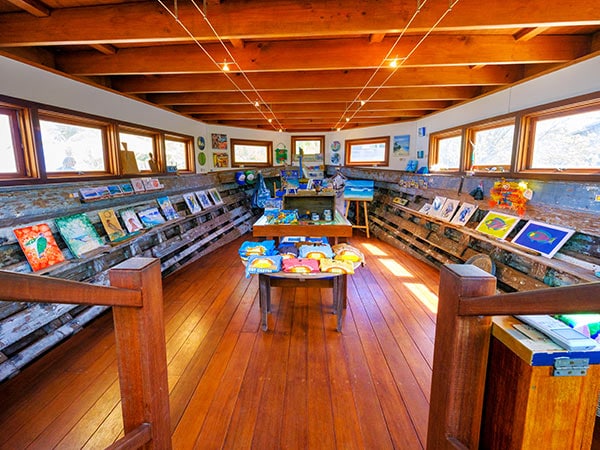
Visit the Big Barge Art Centre for some creativity and culture. (Image: Lynn Gail)
All-things-coconut
Join a farm-based tour with Cocos Artisans Collective and see behind the scenes of a coconut production centre during a 1.5-hour demonstration. Learn about the timeworn techniques the farmers employ to create their products.
Cocos is laden with coconut palms – you’ll discover how they are utilised to make a range of goods, including tasty coconut chips and delicious ice creams. And you’ll get to enjoy free tastings afterwards in the farm shop.
Cocos Artisans Collective also produce a range of coconut-based body balms.
T-off with locals
Scrounger’s Golf is played every Thursday afternoon across the airport’s international runway. It’s an island-initiation must-do – like taking the Polar Plunge in Antarctica, though not nearly as cold.
The nine-hole round is all about teamwork, boardies, beers, and banter, rather than getting a ball on the putting green.
Make your way to the Donga, West Island’s local club, sign up, grab some coldies, and hire your clubs, ready for tee-off at 3.30pm.
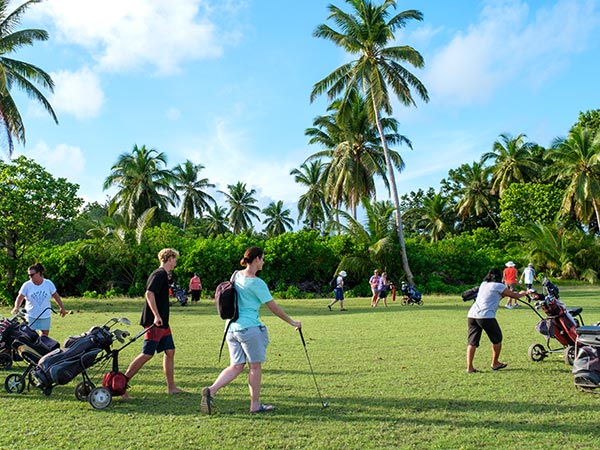
Play golf across an international runway, just to say you have. (Image: Lynn Gail)
Where to dine
After exploring deserted beaches, luxuriating in warm crystalline waters whiling away hours in contented bliss, you’ll no doubt be thinking about satisfying your taste buds.
With Cocos’ land mass measuring a mere 14 sq km, restaurants are limited. However, there’s a good range of Australian, International and Malaysian fare available.
West Island
Watch the fading sun dance through waves from your lantern-lit table at Saltmakers by the Sea . Saltmakers offer a range of delicious dishes and have special themed nights, like Coconut Night on Thursdays.
Chalk your name up on the outside blackboard or drop in to book. The restaurant also opens for breakfast periodically throughout the week – try their tasty avo and bacon toasties with freshly brewed coffee.
Pull up a stall next to the locals at Salty’s Grill & Bakery , located externally at the airport. Get your caffeine fix, fresh croissant, pastry or toastie in the mornings.
Pop in on Wednesday for Cocos Malay Curry night, or Friday for Fish, Chip & Salad night. Salty also serves up freshly made pizzas to order, and a range of sushi.
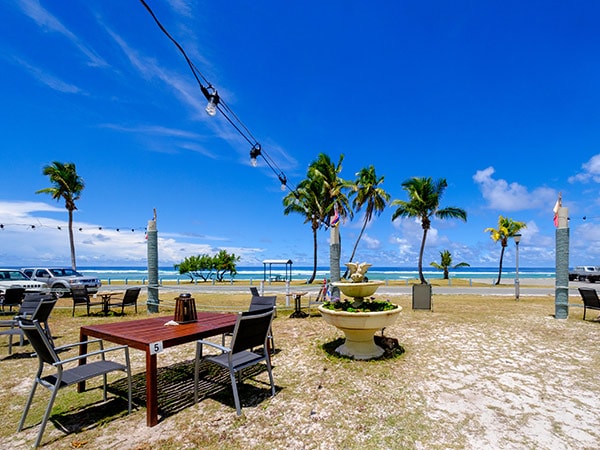
Dine alfresco by the ocean at Saltmaker’s By The Sea. (Image: Lynn Gail)
Add Tropika Restaurant at the Cocos Beach Resort. Buffet style Malaysian and Australian, breakfast, lunch and dinner 7 days.
Open daily from 5pm onwards, the Cocos Club is a family-friendly hub, pub and foodery rolled into one. Relax with a cocktail or coldie and play a game of pool as you catch up with locals. They’ll tell you where the surf’s up and where the fish are biting.
Get intimate with your loved one by ordering a delicious spread with Cocos Picnics . They’ll put together a delicious, handmade grazing platter for you to indulge in – your only decision will be which deserted, soft sandy beach to hideaway on.
The basket is filled with gourmet goodies, rugs, cushions, candles, and fairy lights – there’s even a pack of cards, a low-ground picnic table and a speaker for your playlist as you lay back to unwind under lazily swaying palms.
Home Island
Catch the ferry across from West Island for an authentic Malaysian dining experience at Home Island’s Seafront Restaurant .
Book in for the cultural infused Wednesday Night Buffet Dinner and try flavoursome Cocos Malay dishes from the smorgasbord spread.
During the day the restaurant is open for breakfast and lunch. Taste their range of bubble teas for a sweet refreshment. Book through the visitor centre or directly with the restaurant.
After exploring Home’s Island peaceful Kampong (traditional Malaysian village) continue your cultural immersion at Island Brunch Café with their western-infused Cocos Malay dishes and speciality iced drinks.
Order a takeaway and dip your toes in the water at the lagoon’s edge. The sweeping layers of aquamarine hues are incredible. Pinch yourself to ensure you’re not at home daydreaming, turning pages of a glossy visit-paradise holiday brochure.
Lynn Gail is a travel writer and photographer who supplies both Australian and international travel magazines with features she hopes take readers on immersive journeys. An intrepid traveller, she’s most at home sitting alongside indigenous cultures, learning age-old belief systems. With her photography, Lynn aims to capture an essence of her subjects through making a connection.

LEAVE YOUR COMMENT
Cancel reply.
Save my name, email, and website in this browser for the next time I comment.
Comments (2)
You didn’t mention taking the ferry to Direction Island and snorkelling The Rip…it’s an amazing experience!
I was most interested in reading about these islands and feel rather ignorant as to why I’ve never heard of them considering I’ve been visiting Perth for many years. I will be arriving in Perth on my world trip and I’m very interested In visiting.
You might also like
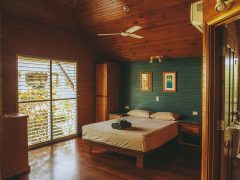
Your complete guide to accommodation on Cocos (Keeling) Islands
You’ve scoured the internet for an untrampled nature-based destination and happened upon Cocos (Keeling) Islands – a tropical, coconut palm-covere...

© Australian Traveller Media 2024. All rights reserved.

Welcome to the Turks and Caicos
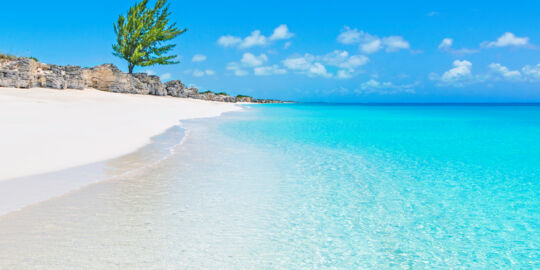
Your Turks and Caicos Vacation
The Turks and Caicos is a small tropical archipelago nation located south of the Bahamas. Our islands offer spectacular beaches, a pristine marine environment, luxury resorts, friendly people, and fine dining.
There’s so much to do and discover. Incredible beaches, crystal clear ocean water, and abundant marine life are yours to explore. Quite simply, the Turks and Caicos is the best beach destination.
It’s easy to experience paradise. The TCI welcomes direct flights from many cities in the United States and Canada, as well as London and several countries in the Caribbean. English is our official language, and we use the US Dollar.

Incredible Beaches
Other Caribbean destinations offer giant water parks, nightlife, casinos, or the extravagant Carnival . Our tourism claim to fame is a bit closer to nature– we have the best beaches in the world . Of course, this is a tremendous assertion, but after a few steps on our powdery sand, you’ll agree too. The experts concur, as the Turks and Caicos have taken the World Travel Award’s title of Caribbean’s Leading Beach Destination and TripAdvisor’s Best Beach in the World many times.
Pristine white sand beaches and ocean water with turquoise and blue hues define our coasts. And we don’t just have one or two great beaches, as every island in the country hides many wonderful and secluded beaches.
The unrivaled and world-famous Grace Bay Beach is the country’s crown jewel, and has won countless awards and recognition. The beach is true paradise, with breathtaking beauty. A full collection of all-inclusive resorts, luxury hotels, and vacation villas are on Grace Bay.

Our Beautiful Islands
The Turks and Caicos has forty islands and cays, of which nine are inhabited. With an area of 238 mi² (616 km²), the TCI is about twice the size of the Florida Keys.
Providenciales, often simply called Provo , is home to the spectacular Grace Bay Beach, luxury resorts, and hotels, and is the destination of choice for many of our visitors. It’s also where the majority of our population reside. All international flights to the islands arrive on Providenciales.
Grand Turk has the country’s capital city of Cockburn Town and our only cruise ship port . The island offers interesting historical sites and exceptional scuba diving.
North Caicos, Middle Caicos, South Caicos, and Salt Cay are our quiet outer islands, and are laid-back and a bit more down-to-earth. These hidden gems are primarily supported by low-key tourism and small-scale fishing.
The Turks and Caicos also has the two large uninhabited islands of East Caicos and West Caicos , and the private boutique islands of Ambergris Cay , Pine Cay , and Parrot Cay .

Hotels, Resorts, and Villas
The choice of luxury hotels, all-inclusive resorts, and vacation rental villas in the islands is extensive.
Provo hosts most of the resorts in the country. Choose from beachfront suites on the award-winning Grace Bay , or comfortable luxury villas overlooking the brilliant waters of Chalk Sound Lagoon , Turtle Tail , or Long Bay .
Many of our luxury resorts have received international acclaim, including the Grace Bay Club , Amanyara , Wymara Resort , The Shore Club , West Bay Club , The Palms , and Seven Stars Resort .
There are also several all-inclusive resorts, including family-oriented Beaches Turks & Caicos (part of the Sandals group), Alexandra Resort , Blue Haven Resort , and the adult-only Club Med Turkoise . Properties boast an impressive range of amenities and services, including spas and exquisite in-house dining, and are also perfect for weddings and honeymoons.
Rental villas can be an excellent choice for larger groups. Amenities may include a pool, use of a car, airport pick-up, visits to the spa, and private chef services. Great villa locations include Leeward , Long Bay , Turtle Cove , Sapodilla Bay , Chalk Sound , Taylor Bay , and Turtle Tail .

Where Turks and Caicos Is Located
The Turks and Caicos Islands (TCI) are located between the Bahamas and the Dominican Republic. It’s a 90-minute flight from Miami and less than 4 hours from New York and Toronto.
The Turks and Caicos geographically is part of the Lucayan Archipelago , which includes the TCI, the Bahamas, and the marine plateaus of the Mouchoir Bank , the Silver Bank , and the Navidad Bank .
Domestic flights and small passenger ferry boats connect the inhabited islands in the Turks and Caicos.

Perfect Weather All-Year Round
What good is a top-rated beach without sunny weather and a perfect climate? The sun is almost always shining here, temperatures are consistently warm, and there’s very little rain to dampen the mood. Throughout the year, our ocean water temperature maintains a pleasantly-warm and serene average in the mid-80°F range (29°C).
The Turks and Caicos experiences a change in tourist arrivals throughout the year. The winter months are the “high season”, and the quieter autumn months are referred to as the “low season”. Hotels and activities are often discounted during the low season, so it’s a great time to save on vacation costs.

Attractions and Things to Do
An expansive barrier reef , one of the largest in the world, protects our coasts, and is home to vibrant marine life and coral.
The sheltered mangrove channels of the Turks and Caicos are amazing spots for stand-up paddleboarding and kayaking . You’ll see conch, turtles, stingrays, baby sharks, and bird life the way they are meant to be seen: in their natural environment.
Our incredible reefs and beaches aren’t the only attractions. Caves , historical sites, national parks, and the award-winning Royal Turks and Caicos Golf Club await. We also have a small museum that features artifacts spanning over 1000 years of history and culture, art galleries, and the unique and friendly Potcake dog , which is the best island pet around!
Want to get your heart racing? Take in the view from above by parasailing over Grace Bay, go horseback riding on the beach, or cruise the turquoise Caicos Banks on a jet ski . For anglers, a fishing charter can be a perfect way to spend a day on the water. We have incredible deep sea, reef, and bonefishing.
On the breezier days, kiteboarding and windsurfing conditions are excellent. The shallow water of Long Bay Beach is recognized as one of the finest kite spots around.

Scuba Diving and Snorkeling
The Turks and Caicos is home to a remarkable and vibrant barrier reef system that surrounds the archipelago. Inside the barrier reef and on the Caicos Banks are many bay reefs too, each of which is unique.
Providenciales and Grand Turk offer a range of professional dive shops, which regularly visit hundreds of lively dive sites across the country. Popular sites include French Cay, West Caicos, the Caicos Barrier Reef, and Northwest Point. For those who’d rather stay a little closer to the ocean surface, a boat snorkeling tour is a great way to experience our marine environment. We have beach reefs too, including Smith’s Reef and the Bight Reef .
There are always fascinating marine animals to spot. In addition to colorful reef fish, turtles, conch, eagle rays, and stingrays are common. You may even see Jojo , our unique and friendly Atlantic bottlenose dolphin!

Boutique Island Experiences
Grace Bay isn't the only place to find luxury in the Turks and Caicos. We have several boutique islands that feature exclusive resorts and real estate developments.
The COMO Parrot Cay Resort on Parrot Cay and the Pine Cay Resort on Pine Cay are two small yet spectacular islands. They are home to incredible beaches and a luxurious and laid-back atmosphere.
Ambergris Cay , located on the remote south-eastern edge of the Caicos Banks, is a private island retreat with breathtaking vistas, low-density development, and a spectacular ecosystem. The nearby pristine nature reserve island of Little Ambergris Cay has some of the finest beaches in the country.
Salt Cay , the longest continually inhabited island in the Turks and Caicos, is another unique getaway and offers the unique experience of a quiet atmosphere, old colonial buildings, secluded beaches, and breathtaking vistas.

Restaurants and Dining
Providenciales has become an exceptional destination for gourmet dining, and offers a diversity of cuisines. Fresh seafood, including conch, spiny lobster, and fish, factor into many dishes. However, international twists and fusions are what make the country’s restaurants so delicious. Many popular restaurants offer a menu combining the top tastes from our islands, Jamaica, the Bahamas, America, and Europe.
If you’d prefer something more authentic, pan-poached grouper and lobster, cracked conch, and fish stews have been favorite local foods for generations. If you’re looking for a complete cultural experience, try a local restaurant that features live music, such as Da Conch Shack, Omar’s Beach Hut, or Bugaloo’s Conch Crawl. Enjoy conch fritters, conch salad, grilled lobster tail, blackened or pan-fried fish, and the ubiquitous peas n’ rice. Conch is the defining seafood in the Turks and Caicos, and we once even had a conch farm!
Grace Bay is home to beachfront restaurants and bars, which are perfect places to grab a drink and watch the sunset. A sunset cruise or glowworm tour is another nightlife option.

Day Trips and Excursions
A day trip to one of the outer islands is recommended, and planning your own adventure is easy.
When in season, humpback whale watching can be incredible, and there may even be the chance to swim with these gentle giants.
An island-hopping boat cruise is the perfect family trip. Along with the stunning beaches and ocean, some of our uninhabited cays are home to a unique and friendly animal—the Turks and Caicos Rock Iguana . Boat cruises often include a little of everything: snorkeling, sightseeing, tube wake riding, and a beach barbecue.

Airports, Flights, and Vacation Packages
It’s easy to get to the Turks and Caicos. Direct flights from major US airlines fly from New York, Miami, Boston, Charlotte, Fort Lauderdale, Atlanta, Philadelphia, and other cities in the United States. Canada is also within easy reach, with direct flights from Toronto and Montreal. There are even flights from London as well. In addition, regional airlines connect the Bahamas, Jamaica, Puerto Rico, and other Caribbean destinations. Once your plane touches down, you can be relaxing on Grace Bay Beach in an hour or two, as you won’t have to spend hours traveling by car or train to get to your hotel.
It’s easy for those that want to rent a car . Our road system is decent, and speeds are limited to 40 mph (64 km/h). We drive on the left, though! If you’d prefer not to drive while on vacation, it’s easy to arrange a taxi or car service.
The time zone observed in the Turks and Caicos is Eastern Standard Time (UTC/GMT-5). We’re in the same time zone as the major US east coast cities, which is very convenient.
As a British Overseas Territory, the Turks and Caicos bases its entry requirements and visa policies on the practices of the United Kingdom. No visa is needed for those with a passport or valid resident or tourist visa from the United States, United Kingdom, or Canada.

- Visit Our Blog about Russia to know more about Russian sights, history
- Check out our Russian cities and regions guides
- Follow us on Twitter and Facebook to better understand Russia
- Info about getting Russian visa , the main airports , how to rent an apartment
- Our Expert answers your questions about Russia, some tips about sending flowers

Russian regions
- Bashkortostan republic
- Chuvashia republic
- Kirov oblast
- Mari El republic
- Mordovia republic
- Nizhegorodskaya oblast
- Orenburg oblast
- Penza oblast
- Samara oblast
- Saratov oblast
- Tatarstan republic
- Udmurt republic
- Ulyanovsk oblast
- Map of Russia
- All cities and regions
- Blog about Russia
- News from Russia
- How to get a visa
- Flights to Russia
- Russian hotels
- Renting apartments
- Russian currency
- FIFA World Cup 2018
- Submit an article
- Flowers to Russia
- Ask our Expert
Saratov city, Russia
The capital city of Saratov oblast .
Saratov - Overview
Saratov is a large city located in the southeast of the European part of Russia, the administrative center of Saratov Oblast, a major cultural, economic, and educational center of the Volga Region.
The population of Saratov is about 818,400 (2022), the area - 2,100 sq. km.
The phone code - +7 8452, the postal codes - 410000-410600.
Saratov city flag
Saratov city coat of arms.
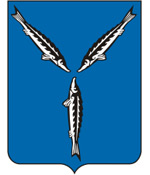
Saratov city map, Russia
Saratov city latest news and posts from our blog:.
4 April, 2019 / Cities of Russia at Night - the Views from Space .
21 November, 2011 / Picturesque landscapes of the Saratov region .
19 November, 2009 / Life of juvenile prisoners in Russia .
History of Saratov
Foundation of saratov.
People already lived on the site of today’s Saratov in ancient times. On the territory of the city there is Alekseevskoye settlement - an archaeological monument that has seven identified cultural horizons from the catacomb culture of the Middle Bronze Age (the 20th-19th centuries BC) to the settlements of the Golden Horde time (the 13th-14th centuries AD) with a temporary break in the 5th-13th centuries.
The settlements in this place regularly appeared during periods of relatively stable state structures (Khazar Khaganate, Volga Bulgaria, Golden Horde) and disappeared without a trace during the next wave of nomads. The last such cycle before the founding of Saratov ended in 1395-1396, during the invasion of Tamerlane (Timur), who destroyed the Golden Horde town of Uvek (Ukek) that stood here.
In the next 200 years, the sparse population of this region was represented by Nogai and then Kalmyk nomads, Cossacks and fishing artels of Russian monasteries. After the military campaigns of Russian troops against the Kazan Khanate in 1552 and the Astrakhan Khanate in 1556, the Tsardom of Russia gained control of vast territories of the Volga Region. Under Tsar Fyodor Ivanovich, it was decided to found several new fortified towns on the Volga River.
In the summer of 1586, the Samara fortress was founded, in the summer of 1589 - Tsaritsyn (Volgograd). In the summer of 1590, halfway between Samara and Tsaritsyn, the Saratov fortress was founded. The exact location of the original Saratov is unknown. In the winter of 1613-1614, the fortress burned down. In 1617, it was rebuilt on the left bank of the Volga, at the mouth of the Saratovka River.
In 1674, Saratov was moved to the right bank of the Volga, to the area of the present Muzeynaya Square. Thus, the city of Saratov was founded three times: in 1590, 1617, and 1674, and each time in a new place.
More Historical Facts…
Saratov in the 18th-19th centuries
In 1700, the population of Saratov was about 2,000 people. The sedentary agricultural population for a long time could not populate the territory of the region. Only those who were attracted by the free life of the Cossacks moved here.
The construction of the Tsaritsyn guard line and other measures taken by Peter I to strengthen security created conditions for the settlement of the right bank of the Volga. Its location at the intersection of the shortest land route to Moscow and the water route from the lower Volga and the Caspian made Saratov an important transit point and a major center for trade in fish and salt.
In 1763, foreigners were invited to settle in the Volga Region. In 1766, Saratov became the center of coordination of German colonists. In 1780, the town became the center of the Saratov Vicegerency. In 1796, it was renamed the Saratov Governorate.
In 1811, the population of the town was 26,700 people. The general plan of Saratov, approved in 1812, became the basis for the development of the town for more than a hundred years. The French invasion of Russia (1812) influenced the life of Saratov. In 1813, the French prisoners of war were exiled here and used for public works to level ravines, build dams, plant gardens. Later, a lot of them took Russian citizenship and stayed in Saratov. Some of them were invited as tutors and teachers to Russian families and educational institutions, others opened their workshops.
In 1828, the Saratov Tobacco Factory, one of the first in the Russian Empire, began production. In addition to it, the town had a rope, tannery, bell, brick, and a number of other factories. Cholera epidemics broke out in Saratov in 1830 and 1848. The epidemic of 1830, which lasted more than one month, claimed up to 10,000 people.
The further growth of crafts and trade stimulated the development of river shipping on the Volga, which became the main transport artery of the Russian Empire. In the 19th century, Saratov turned into a major river port. A very strong impetus for the development of the Saratov Governorate was the construction of the Tambov - Saratov railway in 1871. It connected Saratov with the country’s railway network.
In 1876, the first stationary circus in the Russian Empire was built in Saratov. In 1885, a public art museum was opened, which became a major event in the cultural life of the city. In the end of the 19th century, Saratov was one of the largest centers for the grain trade and flour-grinding industry in the country. It became a major intermediary in the trade of oil products, meat, fish, salt, and wool.
Saratov in the 20th century
In 1908, trams began to carry passengers in Saratov - one of the oldest tram systems in Russia. In 1912, the Saratov Conservatory was opened - the third in the country after Moscow and St. Petersburg. In 1914, its population was 235,300 people. Until the end of the 1920s, Saratov remained the largest of the cities of the Volga Region (larger than Kazan, Nizhny Novgorod, Samara, etc.) and was often unofficially called the “capital of the Volga region”. From 1928 to 1932, Saratov was the administrative center of Lower Volga Krai, since 1934 - Saratov Krai, since 1936 - Saratov Oblast.
The rapid development of the city took place during the Second World War, when a number of factories and military schools were evacuated here from the west of the USSR. Saratov was subjected to several German air raids, the main purpose of which was to destroy the bridge over the Volga and the oil refinery.
Before the war, the town of Pokrovsk (Engels) located just across the Volga River was the capital of the German autonomous region with a population of about 800,000 people. A lot of them (about 400,000) were exiled to Siberia and Kazakhstan during the war; some later came back. Since the 1980s, most of them have emigrated to Germany. Until now, the few surviving buildings in the pseudo-Gothic style remind of this page in the history of Saratov.
Yuri Gagarin, the first man in space, studied in Saratov. In 1955, he graduated with honors from the Saratov Industrial College. After his historic flight, Gagarin also landed about 35 km from Saratov - on the left bank of the Volga.
Saratov’s population peaked in 1987 - 918,000 people. Until 1992, Saratov was a closed city (foreigners were not allowed to visit it), since several large enterprises of the Soviet defense industry worked in the city, in particular, the Saratov Aviation Plant, which produced military and civil aircraft. Several industrial enterprises in Saratov also carried out orders for the Soviet space program.
Streets of Saratov

Street traffic in Saratov
Author: Kiyanovsky Dmitry
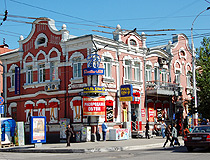
Picturesque old building in Saratov
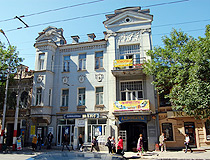
Architectural monument in Saratov
Saratov - Features
Saratov stretches for 34 km along the right bank of the Volgograd Reservoir (the Volga River) opposite the mouth of the Saratovka River and the city of Engels, which is located on the opposite bank. The distance from Saratov to Volgograd - 376 km, Samara - 425 km, Moscow - 847 km. The City Day of Saratov is celebrated on the second Sunday in September.
There are several hypotheses about the origin of the name of Saratov. One of the main versions is that Saratov got its name from Sokolovaya Mountain, which was called “sary tau” in Tatar meaning “yellow mountain”. There is an assumption that the name came from the words “sar atav” - “low-lying island” or “saryk atov” - “hawk island”. It is also possible that Saratov got its name from the Scythian-Iranian hydronym “Sarat”.
Three silver fish (sterlet) are depicted on the coat of arms of Saratov symbolizing “the great abundance of such fish in this area”. They form the Greek letter “upsilon” meaning “the choice of a worthy path at the crossroads of life’s roads”.
The climate in Saratov is moderately continental. This city is characterized by long (about four months), moderately cold winters and hot, often dry summers. The average temperature in January is minus 7.5 degrees Celsius, in July - plus 22.6 degrees Celsius. The best time to visit Saratov is from late May to early September.
Saratov is located at the intersection of main railway and highway lines, water routes. The international airport “Gagarin” offers regular flights to Yekaterinburg, Krasnodar, Moscow, Nizhny Novgorod, St. Petersburg, Sochi, Surgut, Ufa.
Trains to Moscow regularly depart from Saratov railway station, as well as passing trains to Adler, Astrakhan, Volgograd, Yekaterinburg, Kislovodsk, Kirov, Krasnoyarsk, Nizhnevartovsk, Nizhny Novgorod, Novokuznetsk, Novorossiysk, Perm, St. Petersburg, Simferopol, Tyumen, Chelyabinsk. The river port of Saratov serves only passengers of intercity cruise ships.
Saratov is a large industrial, cultural and educational center. Machine building, chemical and oil industries are well developed here. There are a lot of various attractions in Saratov: historical, architectural, religious and natural, various museums and beautiful parks. The city has a large number of architectural monuments of the late 19th - early 20th centuries.
Main Attractions of Saratov
Victory Park on Sokolovaya Mountain . This memorial complex was created in Saratov in 1975, when the 30th anniversary of the Victory in World War II was celebrated. This large park covers an area of 80 hectares. Here you can find the Eternal Flame, the Museum of Military and Labor Glory, the 40 meters high monument “Cranes”, and a unique exposition of military and civilian equipment with over 200 exhibits.
In 2003, the National Village of the Peoples of Saratov Oblast was opened in the park with real houses, yurts and other dwellings of the peoples of the region. In this place you can feel the atmosphere of the past not only of Russians, but also of Tatars, Armenians, Bashkirs, Georgians, and other peoples living in the Saratov region. In 2013, the Alley “Days of Russian Military Glory” was solemnly opened, on which monuments to prominent Russian commanders and statesmen were erected.
Victory Park is a favorite place for recreation for locals and visitors of the city. The top of Sokolovaya Mountain is one of the highest points in Saratov (165 meters). The observation deck located here offers a magnificent view of Saratov, the Volga River and its islands, the opposite bank, and the city of Engels (Saratov is connected with it by a bridge). Sokolovaya Street.
Cosmonauts Embankment - a street that stretches for 1.5 km along the Volga to the Saratov Bridge. The embankment received its present name in 1962 - after the first cosmonaut of our planet landed near Saratov. The monument to Yuri Gagarin was erected at the beginning of the embankment more than 30 years later. The embankment descends to the Volga in 4 wide terraces. In summer, there is a rental of bicycles, rollers, and gyro scooters.
In 2017, the floating light and music fountain “Heart of the Volga” was opened here. It is located right on the water, its multicolored jets rise to a height of 40 m. The fountain is open from May to October.
The embankment offers an excellent view of the Saratov Bridge (1965) - a reinforced concrete road bridge across the Volga River connecting Saratov with the city of Engels. The length of the bridge is over 2.8 km. It is one of the symbols of Saratov.
Kirov Avenue - a pedestrian street that stretches for 1 km through the historic center of Saratov. Unofficially, the street is called “Saratov Arbat”. Along the entire length of the street there are mansions and houses built in the late 19th - early 20th centuries. The most interesting ones are the neo-Gothic building of the Saratov Conservatory (1902) and the Volga Hotel (1917) built in the Art Nouveau style. The monument to the Saratov accordion, one of the symbols of Saratov, is installed here.
The walking area starts from Kirov Square, where one of the oldest stationary circuses in Russia is located - the Nikitin Brothers Circus. The fountain near the circus is a traditional meeting place. The building of the Covered Market (1916) located here is also worth mentioning.
Pictures of Saratov
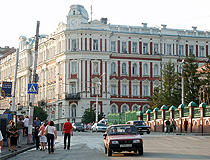
The building of the Volga railway administration in Saratov
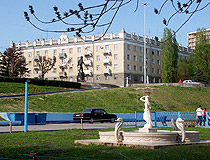
Summer in Saratov
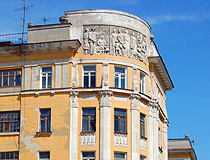
Saratov architecture
Church of the Icon of the Mother of God (1904-1906) - a very picturesque church, the main feature of which is that its multicolored domes resemble the Cathedral of St. Basil the Blessed standing on Red Square in Moscow. In Soviet times, the building served as a city planetarium. So it has been fairly well preserved. Volzhskaya Street, 36.
Cathedral of the Life-Giving Trinity (1689-1695) - the main Orthodox church in Saratov, a unique architectural monument for the Saratov region built in the Moscow baroque style. Moskovskaya Street, 6.
Saratov Regional Museum of Local Lore - the largest museum organization in Saratov Oblast. In total, the museum has about 400 thousand exhibits: archaeological, ethnographic, paleontological, entomological collections, examples of manuscript and early printed books, objects of religious worship, poster graphics, numismatics, materials on the history of the political, economic, and cultural life of Saratov.
Among the numerous exhibits on display in 30 spacious halls, it is worth highlighting the complete skeleton of an ichthyosaur, utensils belonging to the 4th century BC, a rare saber granted by Empress Elizabeth to the clerk Panteley Selivanov. In addition to the permanent exhibition, the museum organizes thematic exhibitions. Lermontova Street, 34.
The Radishchev Art Museum . Created in 1885, it became one of the first publicly accessible art museums in the Russian Empire. The ground floor displays medieval icons and a collection of Western European art, which is considered the third largest in Russia. These are canvases by Dutch, German, French, and Italian artists, furniture and porcelain, bronze and glass products.
On the second floor, you can see the works of Russian painters. Musical concerts and literary and art meetings are held in the Great Hall of this art museum. The library of the museum has a rich collection of manuscripts, old books. Radishchev Street, 39.
Museum of Samovars . This private museum, opened in 2015, houses the largest collection of samovars in Russia - over 700 pieces. Today, in a small room on the ground floor of a residential building, you can see samovars from all over the world and trace their evolution over several centuries. Over time, these ordinary kitchen utensils have turned into works of art and have become one of the symbols of Russia. Kutyakova Street, 34/36.
Gagarin’s Field (Gagarin’s Landing Site) . This attraction of Saratov is located outside the city. On April 12, 1961, the landing vehicle of the Vostok-1 spacecraft with Yuri Gagarin on board landed near the village of Smelovka in Saratov Oblast, several kilometers south of Saratov.
According to the pre-flight plan, the landing was to take place in the steppes of Kazakhstan, but due to a failure in the braking system, Vostok-1 landed on the field of the collective farm “Lenin’s Path”. Yuri Gagarin himself considered his landing near Saratov to be symbolic. In this city the first cosmonaut of the planet attended an industrial technical school.
Today, a memorial complex has been created on this field with a 27-meter obelisk in the form of a rocket taking off. It is a smaller copy of the Monument to the Conquerors of Space located near the Museum of Cosmonautics in Moscow. Near the obelisk, there is a monument to Yury Gagarin, a descent vehicle, and 12 steles with images of the first cosmonauts, Konstantin Tsiolkovsky, and Sergei Korolev. There is a small park around the complex.
Saratov city of Russia photos
Sights of saratov.
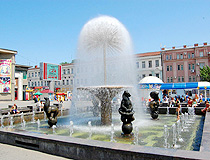
Dandelion fountain in the center of Saratov
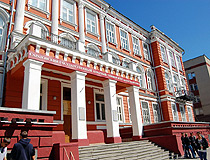
Saratov State Agrarian University
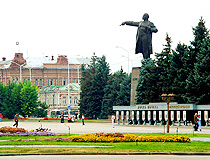
Lenin monument in Saratov
Churches of Saratov
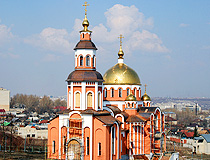
Holy Alexievsky Convent in Saratov
Author: Oleg Maraev
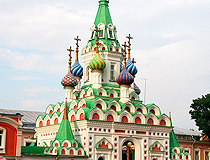
Church of the Icon of the Mother of God Soothe My Sorrows in Saratov
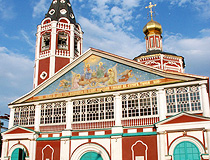
Cathedral of the Life-Giving Trinity in Saratov
The questions of our visitors
The comments of our visitors.
As an American visiting Saratov for the first time I was a little apprehensive, but I was pleasantly surprised with the friendliness of the people, so much so that I returned many times in recent years.
If you are interested in exploring Russia away from the usual Moscow or St Petersburg, you should consider Saratov with its location on the Volga River, interesting city center and landmarks. You will find the people will try and interact with you even if you don't speak Russian. Another wonderful adventure!
- Currently 3.04/5
Rating: 3.0 /5 (189 votes cast)
NEWS... BUT NOT AS YOU KNOW IT
Beachgoers scream after seven foot shark found swimming near British tourist hotspot

Share this with

A beach in the Canary Islands has been shut down after reports of a massive shark in local waters.
As the tail fin of the terrifying creature was seen approaching the shore, young girls could reportedly be heard screaming with police racing in to Melanara beach on Gran Canaria yesterday afternoon.
Not long after 5pm local time, the alarm had been well and truly sounded, with lifeguards helping to clear the sea and a red flag hoisted above the sands soon after.
Horrifying footage shows young people dashing away from the water as the shark thrashed around in the shallows.
One holidaymaker was seen clutching a child in his arms as he watched the giant shark moving through the sea.
A spokesman for Telde Council said: ‘It’s important people stay calm and follow the instructions of the lifeguards and the authorities.’
Speaking with a local TV station, a young girl who was present on the beach for the ordeal said: ‘The lifeguard started blowing his whistle and indicating everyone should get out of the water and I looked round and saw its fin.’

Her friend added: ‘We saw the fin which was about seven inches out of the water and we began to move as fast as we could back towards the beach.’
Authorities swiftly mounted jet skis in an effort to locate the shark, though these efforts were to prove fruitless.

There have not since been any confirmed sightings, though it remains unclear whether the red flag, banning people from entering the waters, will remain in place today.
The shark is understood to have been a hammerhead, which can grow up to 20 feet and at their largest clock in at 1,000 pounds.
Most hammerheads are considered harmless and there have been very few attacks recorded against humans.
It follows after similar warnings were put in place on the Menorcan beach of Arenal d’en Castell, where another telltale fin was spotted above the waves last month.
Get in touch with our news team by emailing us at [email protected] .
For more stories like this, check our news page .
MORE : Why Spain players won’t be singing along to their national anthem at Euro 2024
MORE : I tried No 7’s damage-reversal range for six months to see if it really works wonders
MORE : It’s just become socially acceptable to sit and watch TV for 8 hours straight
Sign Up for News Updates
Get your need-to-know latest news, feel-good stories, analysis and more.
Privacy Policy

Get us in your feed

IMAGES
COMMENTS
A 14.2 sq km drop in the Indian Ocean. Immerse in a tropical oasis of coconut palms, endless white-sand beaches and azure waters. Experience one of the world's largest marine parks teeming with wildlife, discover the unique Cocos Malay culture and historical dramas, and join the friendly locals on island time.
Boat tours: yes. Average temperature range in Fahrenheit: 70 - 90. Average yearly precipitation in millimeters: 7,000. Habitat: coral reef, rainforest, beach. From the port of Puntarenas, it is a 32-36 hour boat ride to Cocos Island. Live-aboard boat tours often incude transport to Puntarenas from your hotel in San Jose.
The Cocos (Keeling) Islands, or simply "Cocos" to locals, are 27 breathtaking islands in an almost perfect circle - only two of which are inhabited. Snorkel, boat, fish, kite surf or dive in the warm, crystal-clear lagoon which forms one of the largest marine sanctuaries in the world. Discover the unique Cocos Malay culture or simply ...
Dieter ran a highly personalised dive trip. HIs professionalism coupled with his experience was outstanding. Diving Cocos Keeling was an exceptional experience - the diving paired with info on the extraordinary history of the islands and the "low key:" tourism on this remote atoll contributed to it being an extraordinary dive trip.
Dates vary from year to year. Please check with the Cocos (Keeling) Islands Tourism Association before booking for events. Visitors to the island are also welcome to participate in the School Fete, Sports Carnival and concert events. Cocos Diving, ☏ +61 8 9162 6515, [email protected]. $200-2320. 2nd Wind Sailboards. July through to ...
Cocos Island National Park. This national park was declared a World Heritage Site by UNESCO in 1997 for its unmatched natural beauty and rich biodiversity. The island is located between parallels 530' and 534' and meridians 8710' and 876' The blue-turquoise water is extraordinarily clear and makes a great habitat for an abundance of marine life ...
Cocos Island National Park. Cocos Island National Park, located 550 km off the Pacific coast of Costa Rica, is the only island in the tropical eastern Pacific with a tropical rainforest. ... Tourism activities around the island, mostly recreational diving, likewise require adequate monitoring and control to prevent disturbance in the highly ...
Cocos Cottages. 32. Cocos Beach Resort. 28. Oceania House Hotel. 4. from $84/night. Cocos (Keeling) Islands Tourism: Tripadvisor has 1,102 reviews of Cocos (Keeling) Islands Hotels, Attractions, and Restaurants making it your best Cocos (Keeling) Islands resource.
Cocos Island is a crucial habitat for other large pelagic species like dolphins, giant manta rays and at least eight types of sharks. Cocos Island National Park encompasses the entire island, protecting its lands and waters. It is Costa Rica's most secluded and least visited national park and can only be reached by a 36-hour boat ride.
Understand. Cocos Island is in the Eastern Tropical Pacific approximately 300 mi (480 km) southwest of Cabo Blanco, Costa Rica. A rugged and incredibly beautiful island, today Cocos Island is the most sacred National park in Costa Rica's extensive park system. Among Cocos Island's many attributes is a startling degree of biodiversity.
Visiting Cocos Island. Coco Island was declared a National Park and conservation area in 1978 and became a UNESCO World Heritage Site in 1997. It is located about 550 km from the Pacific Coast and takes roughly 36 hours to reach. The fantastical atmosphere made Isla del Coco the island double for Isla Nublar in the Jurassic Park movies. For the tourists, it can prove a worthy competitor for ...
Cocos Island National Park. Embark on a journey to one of the most intriguing and biodiverse places on Earth, Cocos Island National Park (in Spanish: Parque Nacional Isla del Coco) in Costa Rica. A pristine paradise with a land area of 23.85 km², known as the "Treasure Island," it is a remote Eden where nature and legend merge.
Hike and Swim. Coco's Island National Park boasts one of the impressive waterfalls in Costa Rica with a swimming pool at the bottom. Don't worry about getting there because the park rangers will guide you while giving a story about the park's extraordinary wildlife. 4. Boating and Fishing.
Staying dry on Cocos Artistic endeavours. Step down into the hull of a restored barge of Big Barge Art Centre, lined with one-off art pieces made from washed-up flotsam and jetsam.. Local artist, Emma Washer pulled the colossal broken-down ship, the Biar Selamat (meaning 'let's be safe') from the overgrown jungle back in 2001.
The Cocos (Keeling) Islands are located in the middle of the Indian Ocean some 2750km north-west of Perth, and 900km west south-west of Christmas Island, its closest neighbour. Cocos lies approximately 12° south and 96.5° east, locating the islands in the humid tropical zone. There are 27 coral islands in the group.
Cocos Island (Spanish: Isla del Coco) is an island in the Pacific Ocean administered by Costa Rica, approximately 550 km (342 mi; 297 nmi) southwest of the Costa Rican mainland. It constitutes the 11th of the 15 districts of Puntarenas Canton of the Province of Puntarenas. With an area of approximately 23.85 km 2 (9.21 sq mi), the island is more or less rectangular in shape.
Cocos refers to the abundant coconut trees, while Keeling refers to William Keeling, who discovered the islands in 1609. Cocos Islands Act 1955; Act of Parliament ... There is a small and growing tourist industry focused on water-based or nature activities. In 2016, ...
Your Turks and Caicos Vacation. The Turks and Caicos is a small tropical archipelago nation located south of the Bahamas. Our islands offer spectacular beaches, a pristine marine environment, luxury resorts, friendly people, and fine dining. There's so much to do and discover. Incredible beaches, crystal clear ocean water, and abundant marine ...
2. Saratov State Museum of Military Glory. 266. Military Museums. By DanieleMIR. if you are interested in soviet war machines, this place is a must visit if you are in Saratov. Really enjoyable. 3. Saratov State Art Museum of A.N. Radishhev.
Saratov is a large city located in the southeast of the European part of Russia, the administrative center of Saratov Oblast, a major cultural, economic, and educational center of the Volga Region. The population of Saratov is about 818,400 (2022), the area - 2,100 sq. km. The phone code - +7 8452, the postal codes - 410000-410600.
As of the 2021 Census, Saratov had a population of 901,361, making it the 17th-largest city in Russia by population. Saratov is 389 kilometres (242 mi) north of Volgograd, 442 kilometres (275 mi) south Samara, and 858 kilometres (533 mi) southeast of Moscow . The city stands near the site of Uvek, a city of the Golden Horde.
Plan Your Trip to Saratov Oblast: Best of Saratov Oblast Tourism. By Alex A. 884. Saratov Oblast. Saratov Oblast Is Great For. Eat & drink. Tary-Bary Restaurant. 347 $$ - $$$ • European, Russian, Soups. Chaikhana Uzbechka. 458 $$ - $$$ • European, Eastern European, Contemporary. CHAPLIN's Gastrobar. 97
Map shows flooded Spanish tourist hotspots as wild weather hits Europe Europe's £8,100,000,000 high-speed train that puts the UK to shame